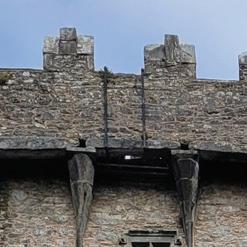








As I write this letter, one would think spring has already arrived – I think most of us feel like we got a much-appreciated “pass” from Mother Nature this winter. I’m sure there are some snow enthusiasts who would not agree …
I think we can all agree that one of the most talked about topics – especially since the pandemic – is our kids’ education. Over the years, we have highlighted many, many organizations and people in Greater Flint who are dedicated to guiding the future well-being of kids in our local communities. is month, we pro le two such individuals – award-winning school counselor Vanita Wilson, and Michigan’s winningest high school hockey coach Doug Towler. Also featured are the Flint Engagement Center, working to reach young people who have become disconnected from education; and the Flint Public Health Youth Academy, encouraging students to pursue public health careers and address health equity in the community. Di erent missions with a common goal to improve academic outcomes.
Another feature shines light on a group founded by two moms who realized our community lacked socialization opportunities for young adults with intellectual disabilities. is story came to us as a reader suggestion; check out “Xceptional Heroes – A Common Bond” starting on pg.8. And, we talked to local lmmaker Lance Johnson about his documentary, “Remembering Flint Central”. Its Flint Institute of Arts debut sold out! See “My History” on pg.34. Wrapping up the content are health, style, food and our great contributed columns.
We’re so grateful to those who choose to support our monthly e orts to create a top-quality local publication. ey’ve kept My City in your mailbox, so I hope you support them in return!
As spring is upon us, let’s celebrate making it through another winter and look forward to enjoying some great times in Greater Flint. anks for reading,

 Publisher &
Publisher &
Sherron
Peter Hinterman
Cheryl Dennison FREELANCE WRITER
Mark Spezia
Erin Caudell
Dr. Christopher Douglas
Vera Hogan
Marc Janca, AIF
Alexandria Pazienza-Nolan
Nicholas R. Robinson. Esq.
Leslie Toldo
Shannon White
Hailey
Daria Akulova
Terese Allen
of the respective authors and not of My City Magazine. My City Magazine is not responsible for returning unsolicited manuscripts, photographs or other materials. Every effort will be made however, to return rejected manuscripts, etc., if they are accompanied by sufficient first-class postage, but the Publisher will not be responsible for any loss of such material.
Copyright© 2024. All rights reserved. | Printed in U.S.A.
 Chief
Chief


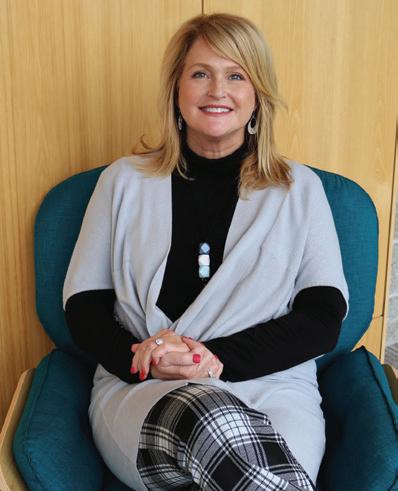
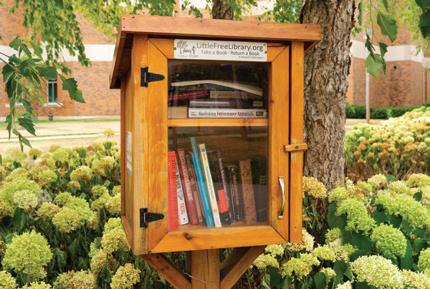

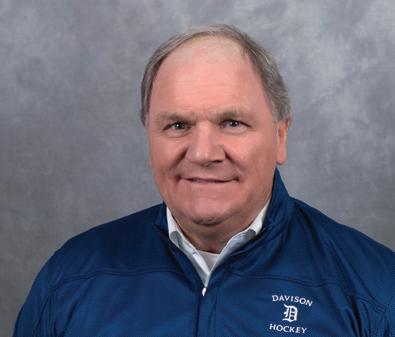
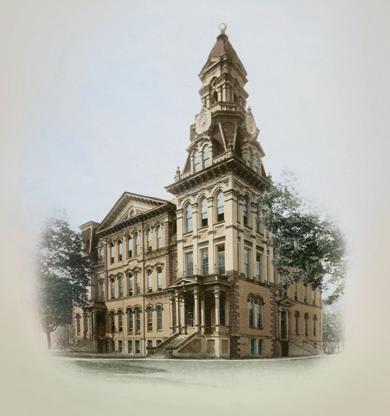





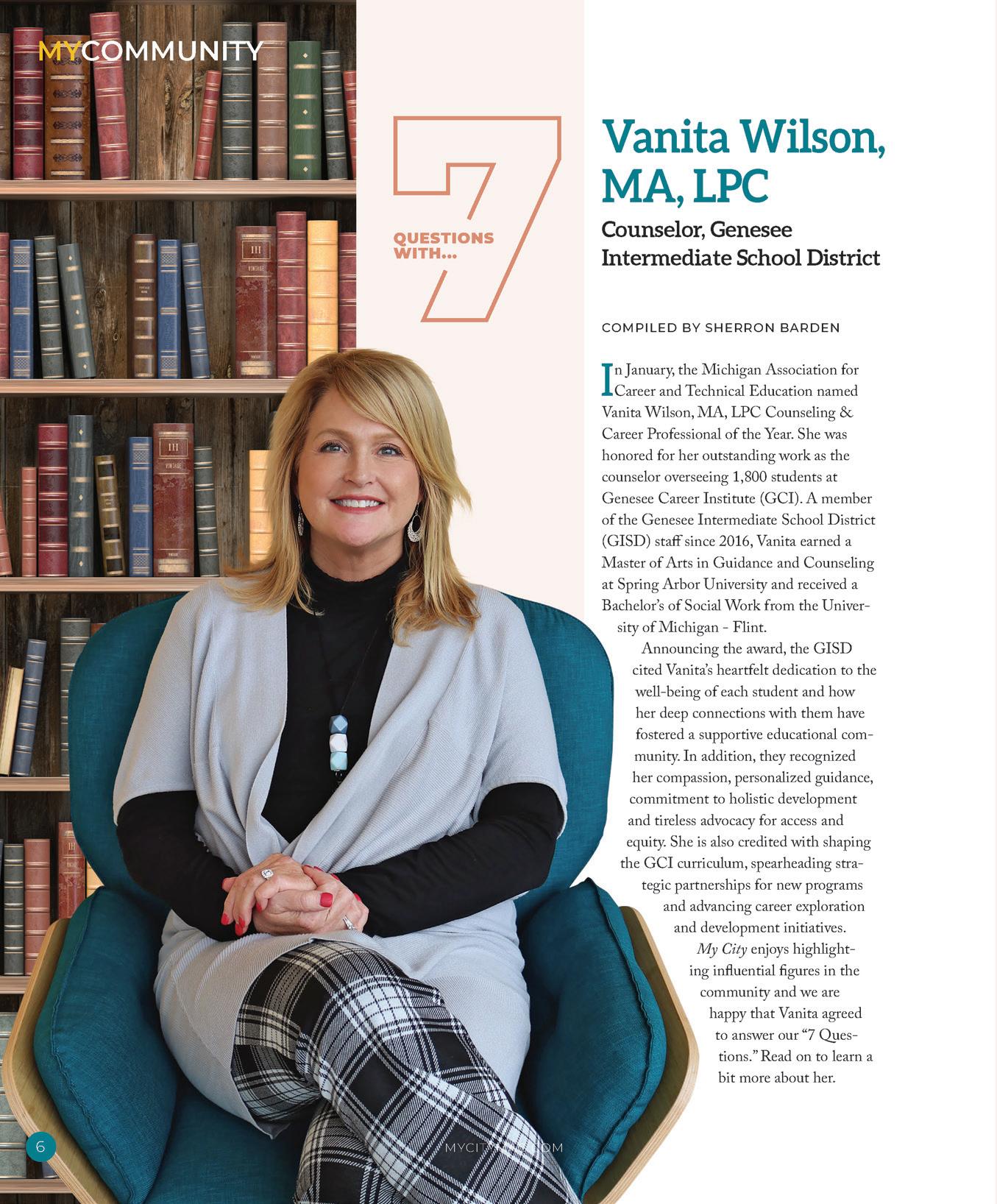



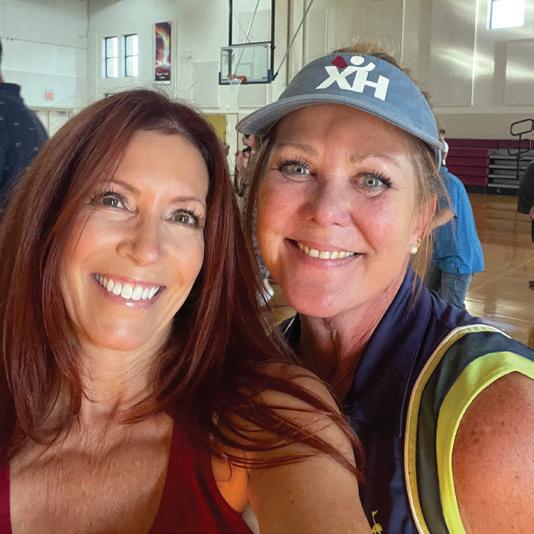 XBY CHERYL DENNISON
XBY CHERYL DENNISON
ceptional Heroes is a group of friends, family members and individuals who are passionate about supporting young adults who have intellectual disabilities (ID). e group was founded in 2016 by Jen Silverton and Teresa White – two moms raising sons Aidan and Tyler – who realized the socialization and relationship void left in their sons’ lives after graduation. e organization began as a private social group to provide a variety of life-enrichment opportunities for young adults with ID.
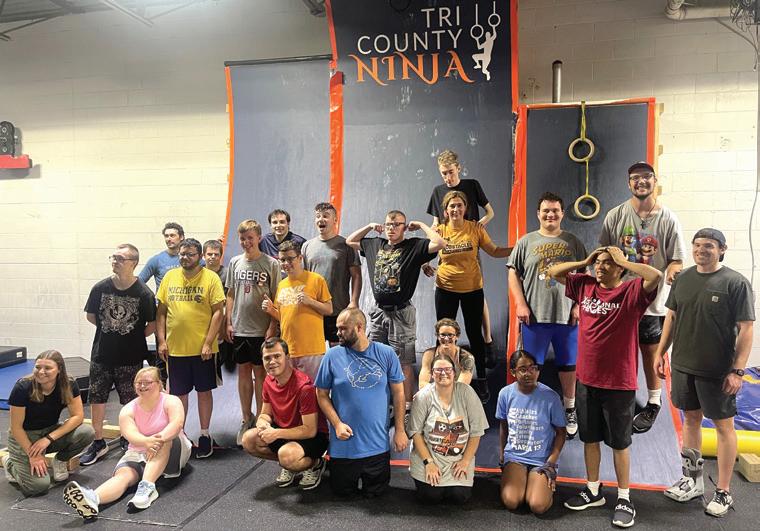
With the help of donations and grants, Xceptional Heroes was established as a 501(c)(3) nonpro t in 2021. e organization’s mission is to provide social, recreational and life skill opportunities for adults with disabilities such as Down Syndrome, Autism, Fragile X Syndrome and others. “Teresa and I were both raising adult sons with ID,” Silverton explains, “and without the structure of school, there was nothing for them to do. We saw the need and it has continued to grow.” Currently, there are 1,000 members who support the cause. And while it started in Grand Blanc, it has branched out to o er the program to all of Genesee County with Xceptional Heroes North serving the population in the ClioMontrose area.
How did they choose the name for their organization? “We feel our people are heroic and we wanted a name that re ected that,” Silverton shares. ey operate with a six-member board of directors, not all of whom are caregivers. Volunteers and family friends help facilitate the program. “Some people are just passionate about the cause,” says the co-founder. →
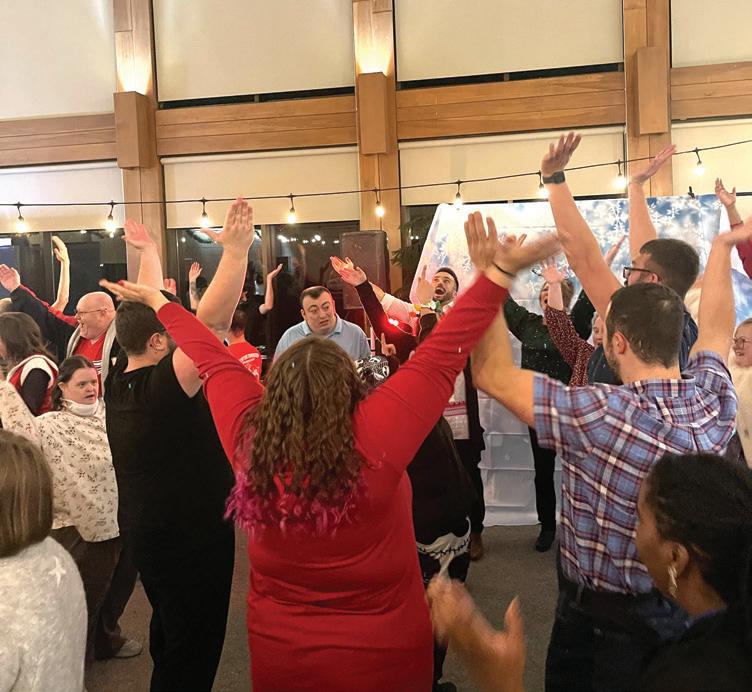
Silverton lists the many fun social events o ered to the Xceptional Heroes such as bowling, game nights, bingo, craft days, social circles, movie outings and dining at area restaurants. Working on a tight budget, they rely on volunteers and donations, she reports. e organization provides activities three to ve days a week and they post a monthly calendar on social media. e March calendar of activities includes bowling, lunch & movie day, a tness hour, yoga and pickleball. ey also have a monthly social event with music and dancing. “We o er something for everyone!” Silverton exclaims. e events are held all around Genesee County.
Xceptional Heroes has a vision for the future, including the possibility of operating in a permanent building where they can provide recreational and possibly residential opportunities and a variety of services. “We are considering all kinds of options,” Silverton shares. “Residential communities are popping up all over the country.”
One of the biggest challenges is lack of transportation to the events, as most of the individuals do not drive. “ is has been a huge obstacle,” Silverton states. “We want to get a van and it is on our radar. Lack of transportation inhibits participation.”
Watching the Heroes form friendships has been most rewarding, Silverton notes. “It is a beautiful thing to witness a Hero coming to their rst event and watch them evolve and see how their sense of belonging develops. ey are young adults – they want their caregivers to drop them o at our events. ey want to be on their own.”
“I love our Heroes, seeing them laugh and smile, watching them grow,” says Silverton. “It is in my blood. is is my passion.”
Support Xceptional Heroes at Galaxy Lanes on April 7 from 1-3pm sponsored by Pins for a Purpose and Above Par Disc Golf Club. Tickets are $20 and 100% of proceeds go to XH! ◆
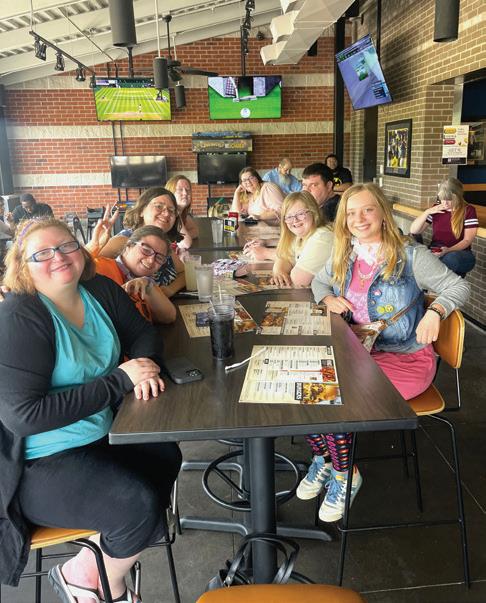
“It is a beautiful thing to witness a Hero coming to their first event and watch them evolve and see how their sense of belonging develops.”
Jen Silverton Co-Founder
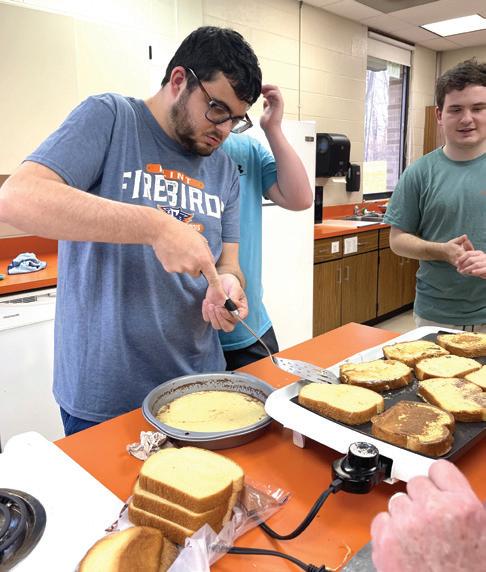

6 Vanita Wilson, MA, LPC Answers
14

16 Flint Public Health Youth Academy: Providing a New Perspective
20 Flint Engagement Center –e Path to a Brighter Future
24 Little Free Libraries Enhance Neighborhoods, Increase Literacy
28 More an a Record: Coach Doug Towler’s Milestone
34 Lance Johnson ’s Documentary “Remembering Flint Central”
A topic at the forefront of the news today, the ways in which kids are educated continue to evolve in the face of many new challenges. My City has featured many initiatives and organizations that are driving e orts to improve academic outcomes and well-being for kids in our local communities, and there are many inspiring success stories.
Flint and Genesee County have an educational attainment rate of 90% (high school diplomas or higher) – greater than the national average.
ree notable higher education institutions including Kettering University, Mott Community College and University of Michigan-Flint, as well as several satellite campuses, make quality education attainable right here in Genesee County. In addition, kids have access to local workforce training options and afterschool enrichment programs that help prepare them for their future academic and life journeys.
Highlighted in this issue are organizations and people dedicated to helping kids excel in school and in life by providing educational resources and programs. One is guiding young people who have become

disconnected from education; another encourages students to pursue public health careers. We o er a reminder about the unique learning opportunities o ered at Sloan Museum of Discovery and Longway Planetarium – two fantastic places for kids to explore and discover. Want to do something great for your neighborhood or hometown? Check out the piece on Little Free Libraries, helping to increase literacy in the purest way. Also pro led are an award-winning school counselor, a history-making local high school hockey coach and a lmmaker who created a documentary about historic Flint Central High School.
Our choice to focus on education this month led us in many di erent directions – we hope you enjoy this special issue.
Looking for a fun and interesting way to supplement a child’s education? e Sloan Museum of Discovery stands ready to take kids through a vast array of challenging workshops and programs.
Since its doors rst opened in 1966, the museum has been a hotspot of student activity and after a fantastic remodel (completed in 2022), has expanded its educational opportunities. Each year, the museum hosts hundreds of onsite and o site STEM and social studies workshops for schools, eld trips, scouting programs, library programs and summer camps. Sloan and Longway educators served
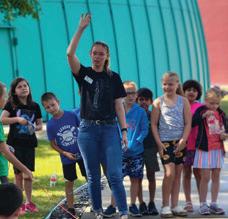

 BY PETER HINTERMAN PHOTOS COURTESY OF SLOAN MUSEUM OF DISCOVERY
BY PETER HINTERMAN PHOTOS COURTESY OF SLOAN MUSEUM OF DISCOVERY
approximately 90,000 students in 2023, including an increasing number of homeschooled groups.
e passionate and dedicated education sta are led by Laurie Bone, Director of Education & Outreach, and Katie Bancroft, Curator of Education & Outreach Programs who aligned the educational programs with curriculum required by State of Michigan schools.
Sloan Museum of Discovery hosts a menagerie of workshops teaching subjects such as physics, architecture, meteorology, sound & light, ecology, chemistry, archeology, biology and more. A few of the most popular science workshops include Amusement Park Science (an interactive workshop about roller-coaster science), Worm Motels, Galactic Goo, Eye Dissection, Flinging ings, and the science of making ice cream. Multiple summer camps are available, organized by age from preschool through high school.
e new Sloan Museum of Discovery was built with learning at the forefront and features three state-of-the-art learning labs for eld trips and classes. e Discovery Lab is a free maker’s space within Discovery Hall and plays home to the popular LEGO® building clubs and engineering workshops. e Longway Planetarium has two classrooms for
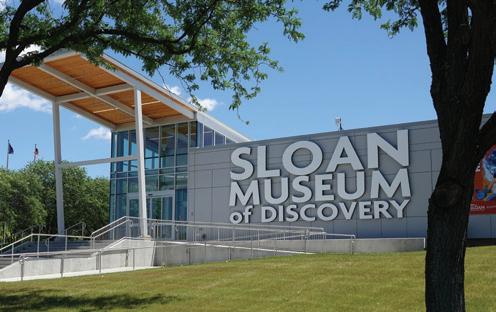

STEM workshops plus the state-of-the-art planetarium dome used to teach kids about space and astronomy. e Sloan and Longway sta go above and beyond to provide STEM programming o -site at partner schools including Flint Cultural Center Academy, Sylvester Broome Empowerment Village and Flint Hamady schools.
Approximately twice per year, Sloan Museum of Discovery hosts special science-related exhibits in the FUN Gallery exhibition hall. e current exhibit “Mazes & Brain Games” is a fun adventure of 3-D puzzles and physical challenges to test all age groups. Over 60 puzzling experiences put creativity and ingenuity to the ultimate test. “Mazes & Brain Games” will be available through May 19, 2024.
e Sloan Museum of Discovery and Longway Planetarium are the top destinations for fun and learning in Genesee County and thanks to the Cultural Enrichment millage passed in 2018, general admission is free to County residents and Planetarium shows are half-price.
For eld trip, summer camp, tickets and more info, visit sloanlongway.org ◆
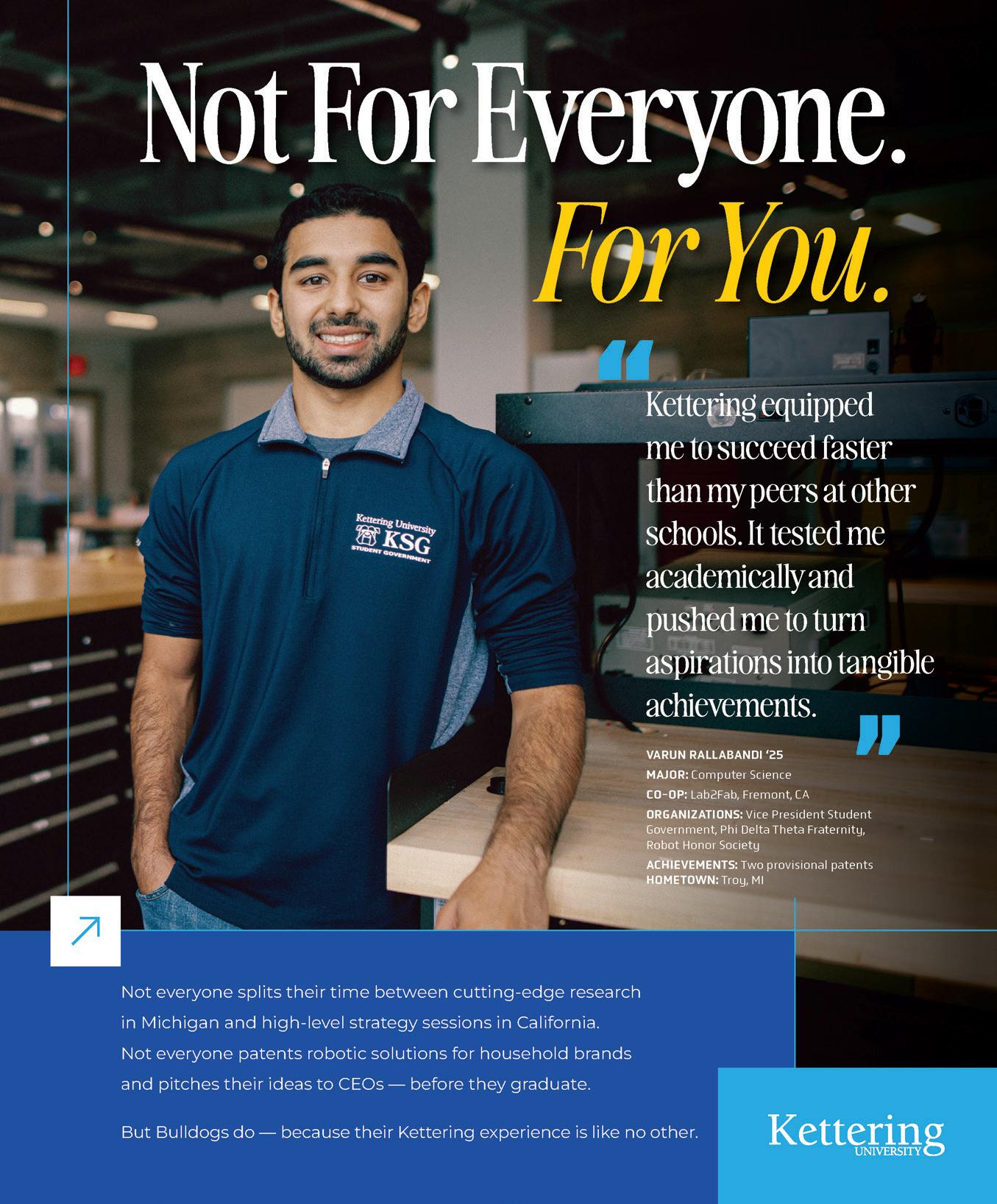

INNovember 2022, Kent Key, MPH, PhD and his academy students stepped o the plane in Boston, MA into a world full of open possibilities. e Flint Public Health Youth Academy (FPHYA) was there on big-time business. ey were invited to give a series of presentations at the annual American Public Health Association (APHA) Meeting & Expo – an honor usually reserved for distinguished health professionals and graduate students. e FPHYA members were an anomaly at the convention – something new and di erent in the realm of public health. e students were young, most still in high school, and they were there to deliver a youth perspective on racism as a public health crisis to public health advocates across the country. ey made an instant splash! ey were rock stars and the impact of the moment
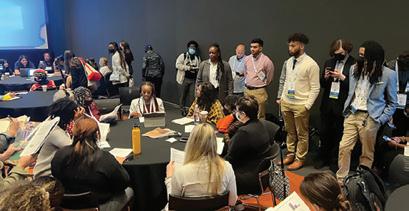
wasn’t lost on Dr. Key. “For many of our students, it was the rst time they had ever left Michigan or even the city of Flint,” he relates. “ ey were new to the situation. I was nervous for them but, as always, they blew me away! It was a great opportunity and what they have accomplished is something that not very many people in the world are able to do at any level.”
e FPHYA’s roundtable and poster presentations proved surprisingly popular at the expo. “I felt kind of bad for some of the other roundtable presenters in the room because many of the attendees were surrounding our table and neglecting the others,” Dr. Key chuckles. “ ey even set up chairs across from our poster which was only supposed to be a roving exhibition!”
FPHYA knocked it out of the park and showcased the great potential of minority youth to contribute to the realm of public health while also acting as an example of the e cacy of the FPHYA program itself.
e Flint Public Health Youth Academy exists as a way for Flint youth to be engaged in the process of understanding the role public health plays in communities, its social determinants, and possibilities for change. For many students, it represents a new way of envisioning and
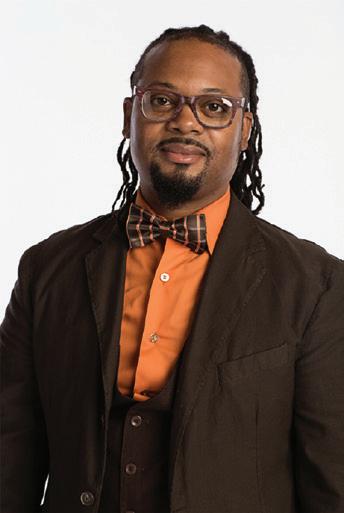 KENT KEY, MPH, PHD HEALTH DISPARITIES RESEARCHER COLLEGE OF HUMAN MEDICINE, MICHIGAN STATE UNIVERSITY
KENT KEY, MPH, PHD HEALTH DISPARITIES RESEARCHER COLLEGE OF HUMAN MEDICINE, MICHIGAN STATE UNIVERSITY
thinking about the world. “It really shed a light on the purpose of activism and advocacy,” says FPHYA Youth Ambassador Cruz Duhart. “When I started ve years ago, I didn’t understand public health. I came to realize that I had the ability to enact change and to scienti cally address the challenges we face. I can do it, too.” A viewpoint of scientist/problem-solver instead of victim encourages participants to consider a future role in the health science
and advocacy realms – something Dr. Key envisioned at the start.
FPHYA was created as a possible solution to a major public health problem, namely the racial and ethnic disparities in health outcomes between the African American and European American communities. “African Americans make up 13% of the population but are dying at greater rates and show more negative health outcomes than the majority of the population,” he informs. While researching this phenomenon, Dr. Key found an actionable determinate. “ e underrepresentation of African American public health professionals may be a contributing factor to the community’s high rates of preventable health disparities,” he writes. “In addition, studies suggest that minorities are more likely to seek medical and health services from individuals of the same ethnicity.” To test this assertion, FPHYA was formed with the goals to “increase minority representation in the elds of public health, medicine and research”, “to create a pathway to careers in public health for Flint youth”, and “to eliminate health disparities by increasing the number of minority health professionals.”
e FPHYA youth are exposed to the scienti c methods used to identify clear barriers to health equity in communities, given the tools to address those barriers grounded in the scienti c method, develop relationships with mentors and role models, and gain valuable experience needed for a successful career in public health. Learning sessions in subjects such as Introduction to Public Health, Social Determinants of Health, Health Policy, Research and Research Methods, Environmental Health and others provide a strong
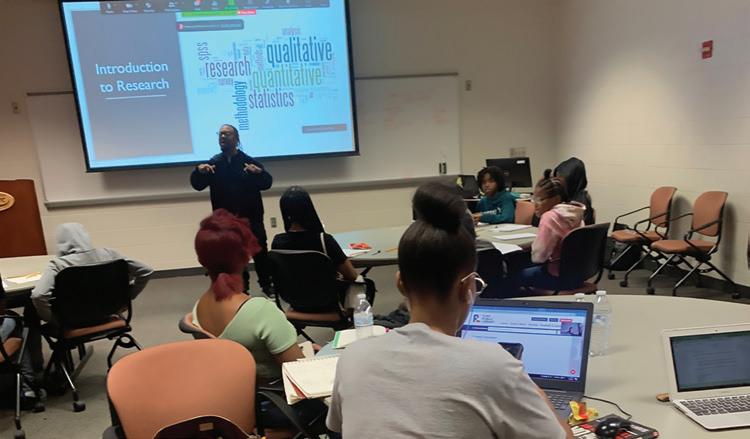
foundation for participants to rely on as they form their ideas and methodology. Concepts in advocacy, activism, and policy reform are added to provide the means of obtaining support and community action. Membership in FPHYA includes students aged 12 and up, each with varying levels of engagement. “We have 12 youth interns and eight mentors,” adds Dr. Key. “On our last day of service at the Food Bank of Eastern Michigan, we had 61 participants.” e program has served over 2,000 youth since its inception.
Each summer, the FPHYA holds a two-week camp on the Mott College Campus where new participants are taught the fundamentals. It is open to highly motivated youth between the ages of 1218 on a rst-come, rst-served basis. “Our program is di erent from any other,” Dr. Key explains. “Where most camps take money for attendance, we do the opposite. We pay a stipend to those who participate. ey can earn $300 for attending and participating for the duration of the camp.” Another way in which the FPHYA stands out is the fact that it is run by its interns and participants. After camp, Dr. Key and sta act as guides to the process. e youth choose the research subject (such as mental health, gun violence, racism, etc.), facilitate youth community dialogues, and
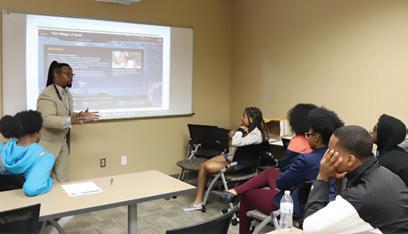
conduct community projects and research. “ e subjects we choose to research and dialogue are largely situational,” says ambassador Everett Graham. “What’s going on in the world around us? For example, our recent dialogue on gun violence really hit home for many of us.” In addition to annual youth dialogues and education sessions, the FPHYA also produces a youth-focused, bi-weekly talk show (available on Facebook and YouTube) taking on a variety of public health subject matters. As the program continues to receive accolades, its participants are regarded as professionals in their own right and have even been contracted by outside organizations for their input regarding a variety of public health topics as they pertain to the youth perspective.
Dr. Key established the FPHYA in the hopes that minority youth in Flint would be more apt to join the public health sector as professionals and so far, it has been a success. e students in his program have →
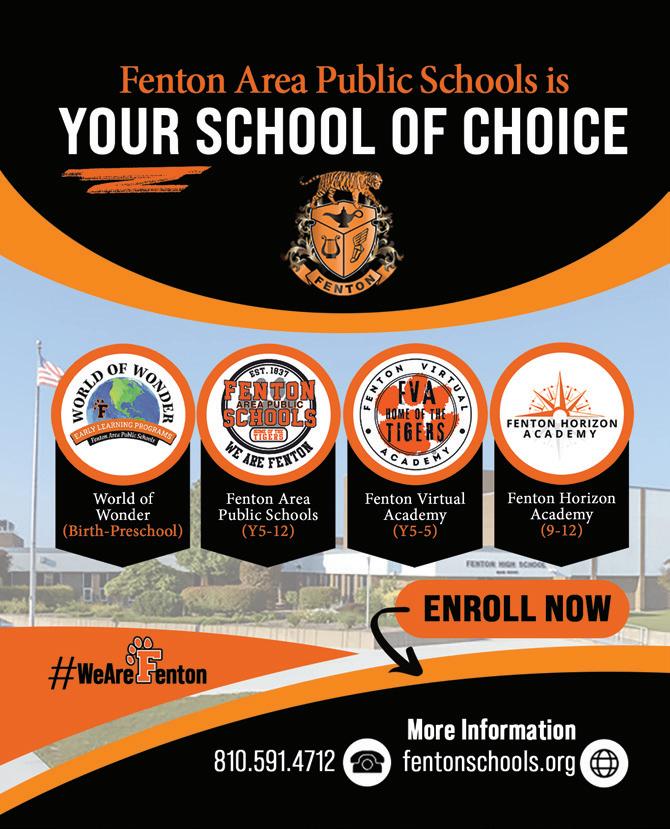

“The underrepresentation of African American public health professionals may be a contributing factor to the community’s high rates of preventable health disparities.”
Dr. Kent Key

gone above and beyond his wildest dreams and in doing so, are taking the program with them. e FPHYA is expanding. “A chapter is beginning in Brooklyn, NY,” he says. “We are also getting interest from Wisconsin, Mississippi, North Carolina, Virginia, California and Tennessee. We are working on going national with the FPHYA model.”
“One big problem in public health is awareness,” adds ambassador Cruz Duhart. “Not everyone is aware of what a healthy community can bring to the table. Many times, those making the decisions are not getting the community members’ perspective of an issue. at results in simply putting a band-aid on the problem instead of xing the underlying cause. Public health advocacy is about healing the community from the inside out.”
For updates and events, visit the Flint Public Health Youth Academy Facebook page. Search FYPHA810 on YouTube to view current and past Youth Perspective Talk Shows.
To get involved with FPHYA, complete the Youth Academy application at cestudio int.org/youthacademy. If you would like to provide support, funding to FPHYA or are interested in the program and/or its research, email Dr. Kent Key at keykent@msu.edu.
e FPHYA would like to thank its partners: Flint ReCast, e Community Foundation of Greater Flint, Black Millennials 4 Flint, and the Robert Wood Johnson Foundation. ◆

INGenesee County, there are nearly 15,000 young people ages 16-to-24 who are not enrolled in school and are unemployed, also known as Opportunity Youth (OY). It is estimated that the pandemic lockdown increased these numbers by a minimum of 25%.
ere is a nonpro t organization in Flint that can help these young people nd a path to a brighter future. e Flint Engagement Center has a mission to connect youth in Genesee County to education, employment and other opportunities to achieve nancial success and independence, according to Program Director Ti any Rouser. e Center, which falls under the umbrella of the nonpro t alternative education provider GEARup2LEAD, is located in the Sylvester Broome Empowerment Village. In April, the organization will move to 141 W. Second St., Downtown Flint.
Since becoming an o cial program in October 2022, the Center has had more than 100 young people referred to

them. Primarily funded by GEARup 2LEAD, the Center has also received a grant from the Ruth Mott Foundation, as well as private donors.
“Our typical participant is disengaged from school and work,” Rouser explains.
“We help them nd educational opportunities that are a good t for them.” e Center has partnered with 30 Genesee County organizations that support its mission to help youth achieve success through community connections. Flint

“There is a definite need for this type of wraparound service. A lot of young adults out there need help connecting.”
Tiffany Rouser, Program Director

Hospital - Trauma Recovery Center, e Luke Center, MADE Institute, Michigan Rehabilitation Services, Mott Children’s Health Center, Mott Community College, Mt. Morris Consolidated Schools, Priceless Dreams, Success Virtual Learning Center, Sylvester Broome Empowerment Village, Teach Me How To Bank, and the Hope Network.
Engagement Center’s 25+ Community Partners include: Boys & Girls Club of Greater Flint, Catholic Charities of Genesee County, City of Flint (O ce of Public Health),Crossover Outreach, Flint & Genesee Group, Flint & Genesee
Literacy Network, Flint/Genesee Job Corps Center, Flint Strive, Genesee County Youth Corporation, Genesee Intermediate School District, Genesee Health System, Greater Flint Health Coalition, GST Michigan Works, Hurley
e Center strives to shed light on the many enrichment opportunities and vital resources that are available, including educational and career opportunities, life skills, basic needs and mental health services, Rouser reports. “In Flint alone, there are over 5,000 opportunities available for the youth!” she exclaims. “We try to determine why they became disconnected, why they dropped out of school, and then we create an individualized plan to address their needs.” With a person-centered approach, a Success Navigator assesses each participant,
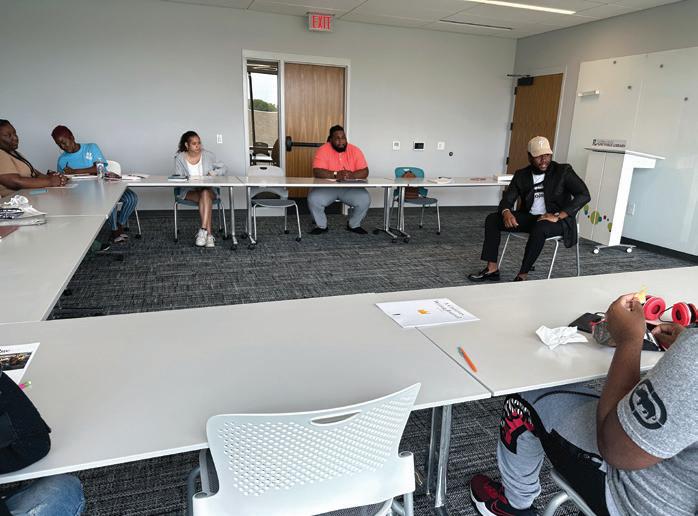
making sure basic needs are met rst. e Engagement Center has successfully connected many of the 100 youths who have been referred to them with various area organizations that o er both academic and
non-academic resources.
“During the summer, we o er a completely free, eightweek course called ‘Brighter Futures: Skills for Lifetime Success’,” Rouser shares. e course features hands-on workshops that cover a wide range of topics including nancial literacy and banking, entrepreneurship, home and car ownership and more. “‘Brighter Futures’ is
designed to help the young adults achieve independence and nancial success and is led by local professionals,” she explains. A $100 stipend is available to those who complete all of the eight weekly sessions.
“ e course was very successful last year and we look forward to doing it again this summer,” Rouser says.
According to Rouser, many people are shocked to learn the number of young people in Genesee County who are disconnected. “ ere is a de nite need for this type of wraparound service,” she states, “but we have a long way to go. ere are a lot of young adults out there who need help connecting.”

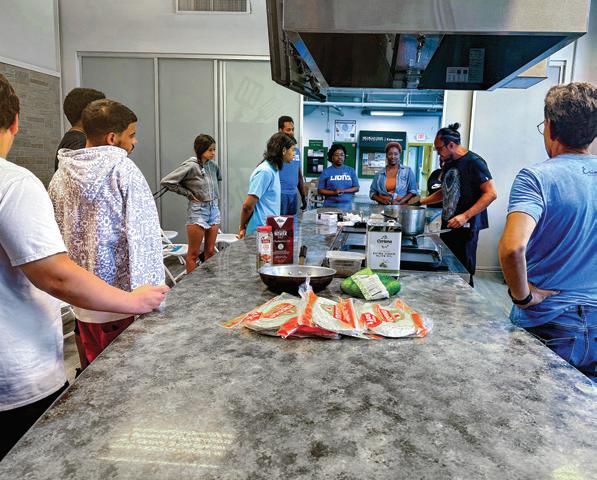
Rouser has found the work she does with youth to be very rewarding.
“It has been really great to help young people succeed,” she says. “While they have the drive, they don’t always know how to get ahead. We provide
“All of our kids are extremely talented and have so much to give to our community if they can reach their full potential.”Tiffany Rouser, Program Director
the connection. All of our kids are extremely talented and have so much to give to our community if they can reach their full potential.”
e Flint Engagement Center is focused on helping to create a skilled
workforce for local businesses and industries, strengthening our economy and community as a whole. To learn more, email info@engage int.com or call 810.545.7070. ◆
Source: engage int.com
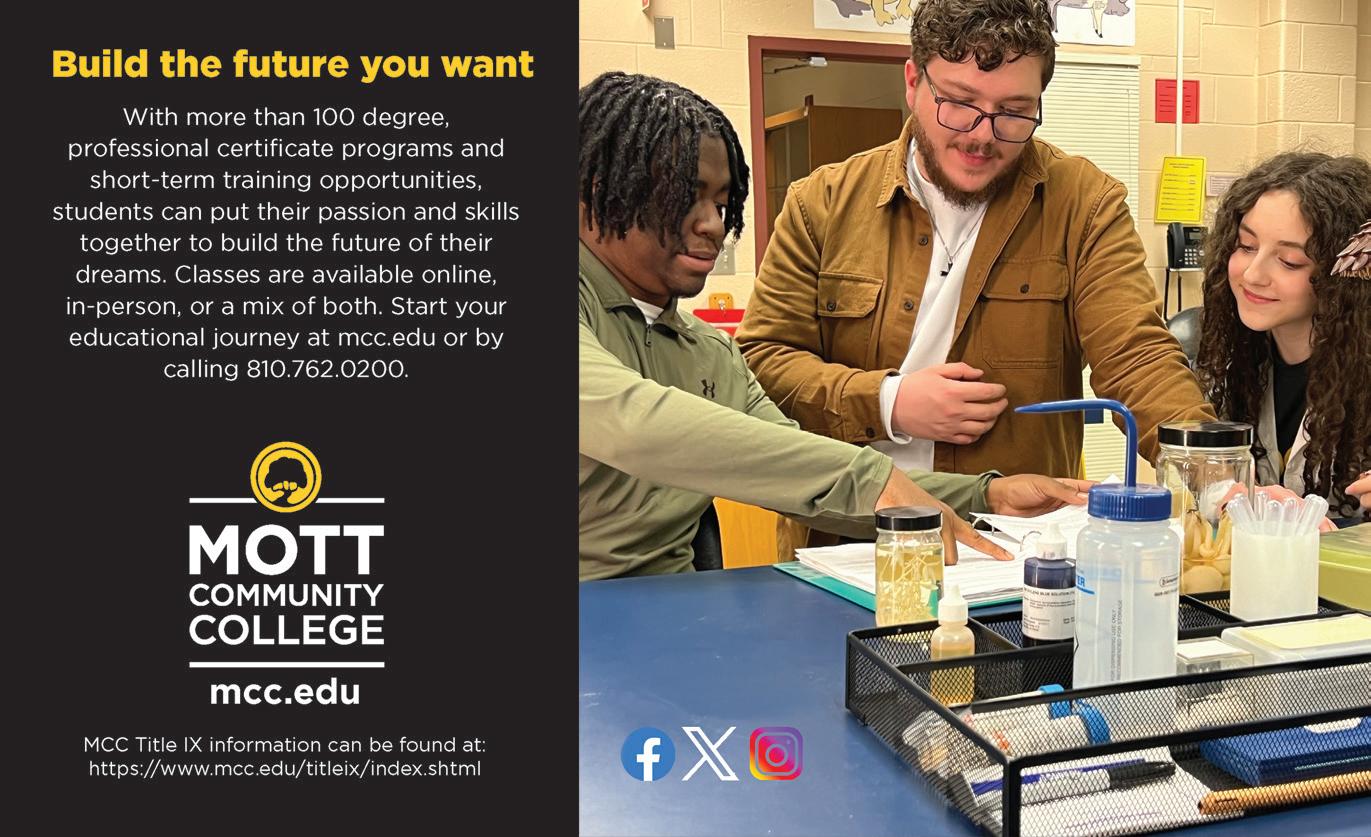
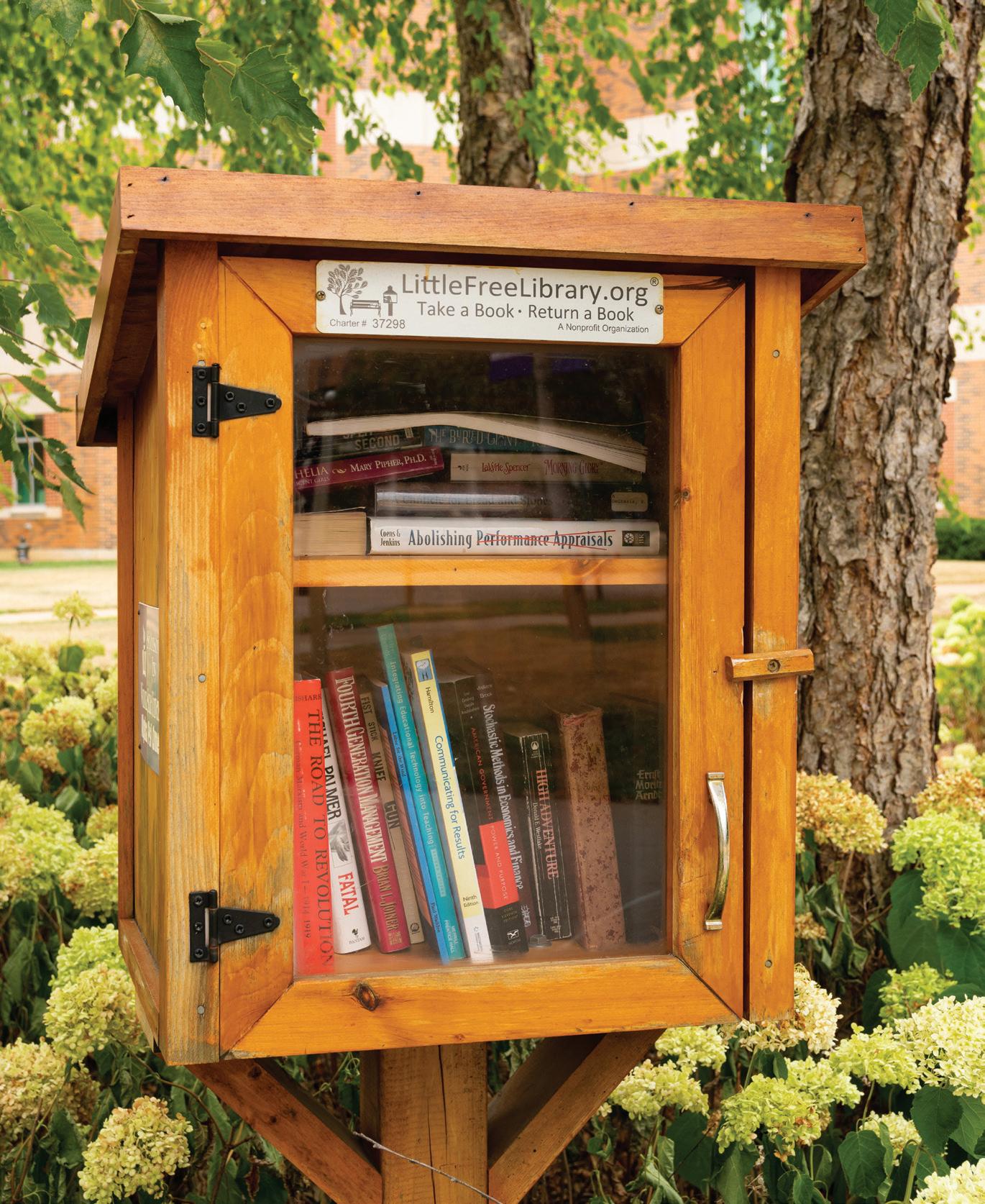

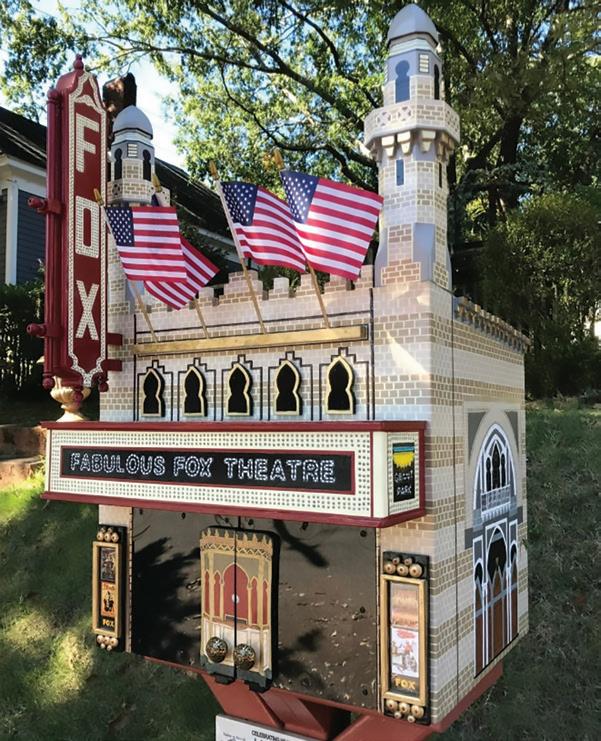
What if I told you that there is one simple thing every community can do to increase the mental health, positive social interactions, feelings of safety, empathy, and good nature of its members? Would you believe me? It’s true. All it takes is a little bit of time, e ort, trust and participation. All anyone has to do is install a Little Free Library®.
e rst Little Free Library (LFL) was installed in 2009 by Todd H. Bol in
Hudson, WI. ereafter, the Little Free Library organization was established in 2012 as a 501(c)(3) in St. Paul, MN and since then, more than 150,000 little free libraries have been registered worldwide. Having an LFL in your community can increase access to books for kids and adults who desire to read (2 out of 3 children living in poverty have no books to call their own), increase feelings of safety and connection amongst neighbors, and
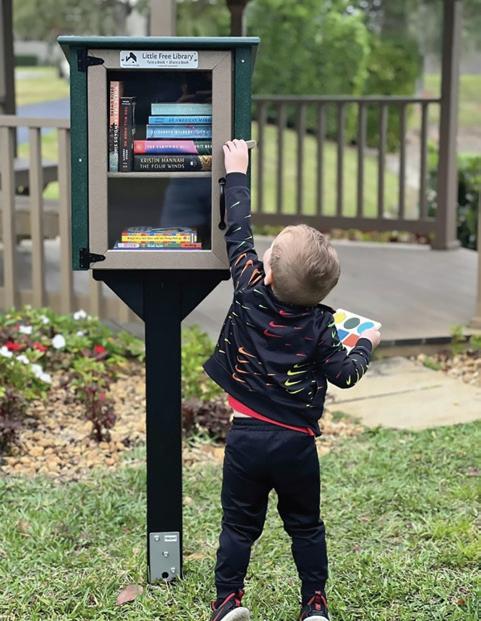

positively impact the mental health and future success of readers.
Literacy amongst children and adults is in decline. Over 30 million adults cannot read or write at a third-grade level and, for the last decade, literacy scores
of early school-age children have been dropping with the number of kids describing themselves as “frequent readers” plummeting with age – the biggest drop happening at age nine with most never returning to the written word. e constant
→
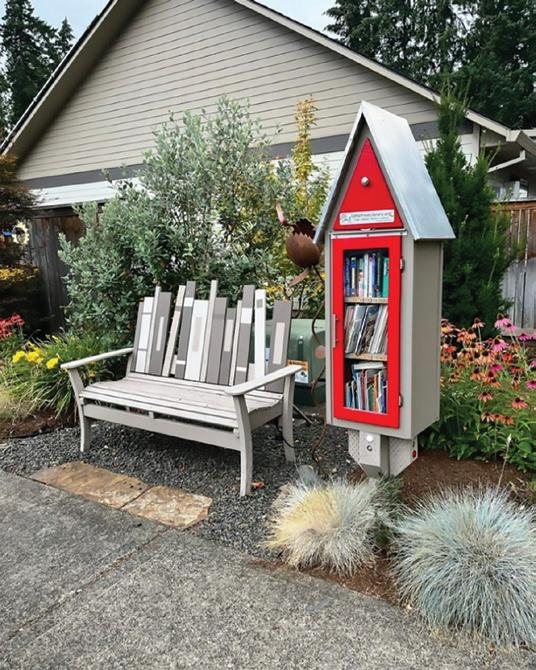
availability of digital media, especially video, has pulled readers from all ages away from the printed page (or screen) and toward non-nurturing forms of entertainment. As a result, literacy scores of children and teens have exhibited a steep drop.
Recent studies show that reading acts as a powerful mechanism for building resilience, developing empathy, growing emotional intelligence, enlarging capacity for critical thinking and nding inner strength in children. Literacy across all ages can change health and is a key mediator between
socioeconomic inequality and health disparities. Youth who are frequent readers report higher con dence and a more positive mental outlook. e biggest predictor of reading success in youth is a parent or guardian who believes in reading and a constant access to new reading materials. A LFL can act as the access; the community can act as the guardian. It’s a win-win situation.
An LFL can be installed anywhere; however, the best location should be one that
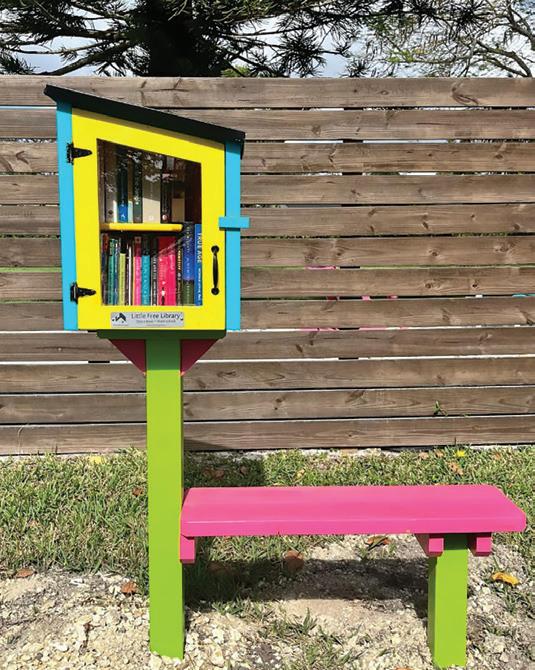
exhibits high foot tra c and high visibility in a place where it can be safely and legally installed. Examples include: parks, churches, city centers, schools, playgrounds, or homes centered in a community. Once a location has been determined, a LFL will need to be built by hand or purchased from the Little Free Library organization website: littlefreelibrary.org. One person should be designated as caretaker or steward of the library and the library should be registered with the Little Free Library organization. Registration provides bene ts to library stewards and location mapping. (Registration costs $50 with proceeds
supporting the Impact Library and Read in Color® programs.) Libraries hold on average between 20 and 100 books with an average of one book being exchanged per day.
For areas known as “book deserts” (lacking literature access) or in communities of need, the Little Free Library organization provides LFLs at no cost through the Impact Library program. To apply for one, visit little freelibrary.org/programs/ impact-library/. Once an Impact Library has been granted, the library steward must abide by these rules:
• Maintain the library and ll it with books for at least one year.
CURRENTLY, GENESEE COUNTY HOLDS OVER 40 OFFICIAL LFLS, THREE OF WHICH ARE IMPACT LIBRARIES. THIS ONE IS LOCATED IN GRAND BLANC’S RUST PARK.
• Hold one or more community activities or events in the rst year.
• Submit a photo and story about the library’s impact.
• Respond to follow-up communications from the LFL organization.
• Respond to media requests when contacted.
Little Free Libraries are an e cient and simple way to increase the good vibes and
literacy of any neighborhood. Currently, Genesee County holds over 40 o cial LFLs, three of which are Impact Libraries. If you know of a book desert or neighborhood that would love an LFL on the corner or in the park, contact the Little Free Library organization at littlefreelibrary. org and get those pages turning toward a happy ending! ◆


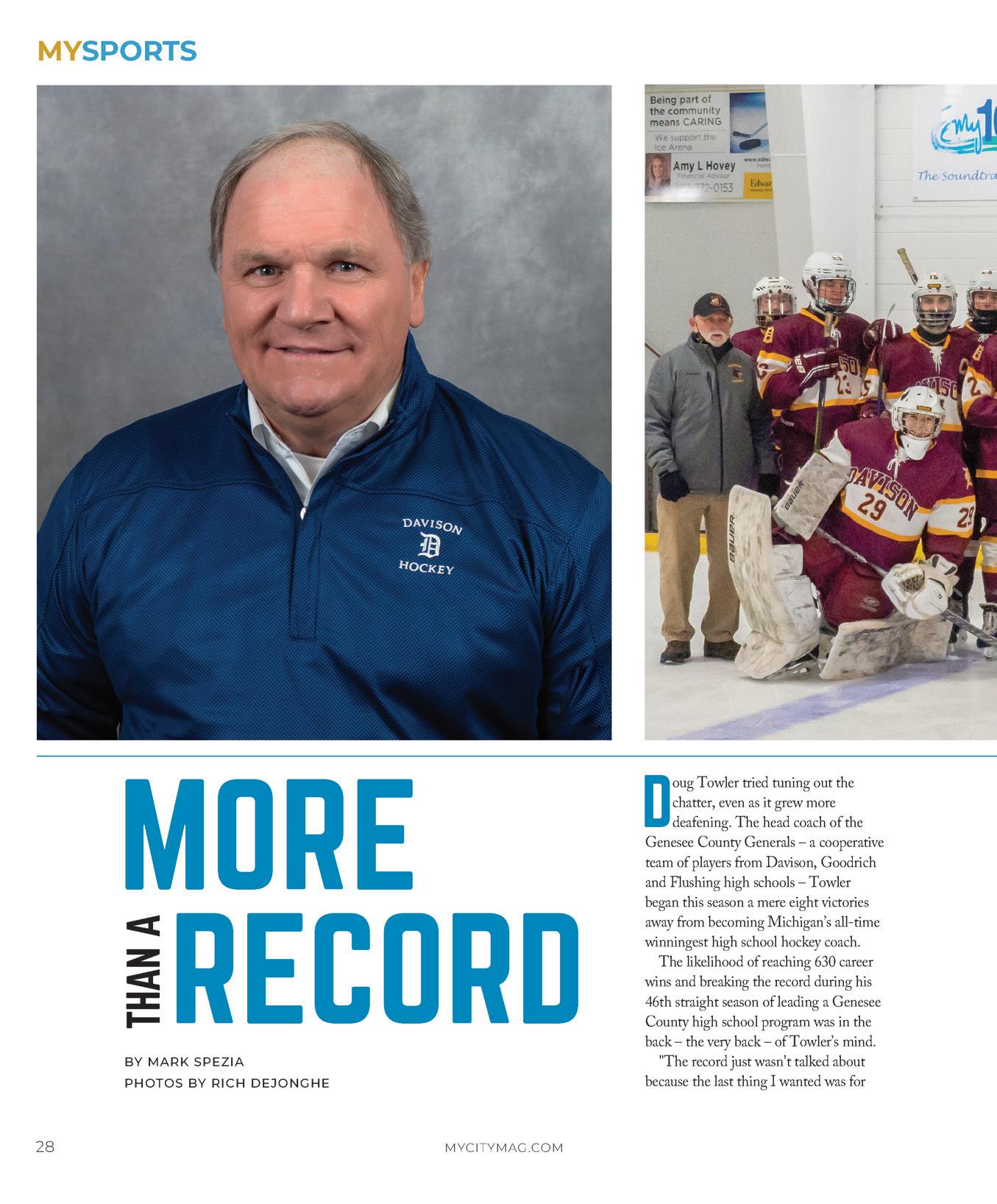

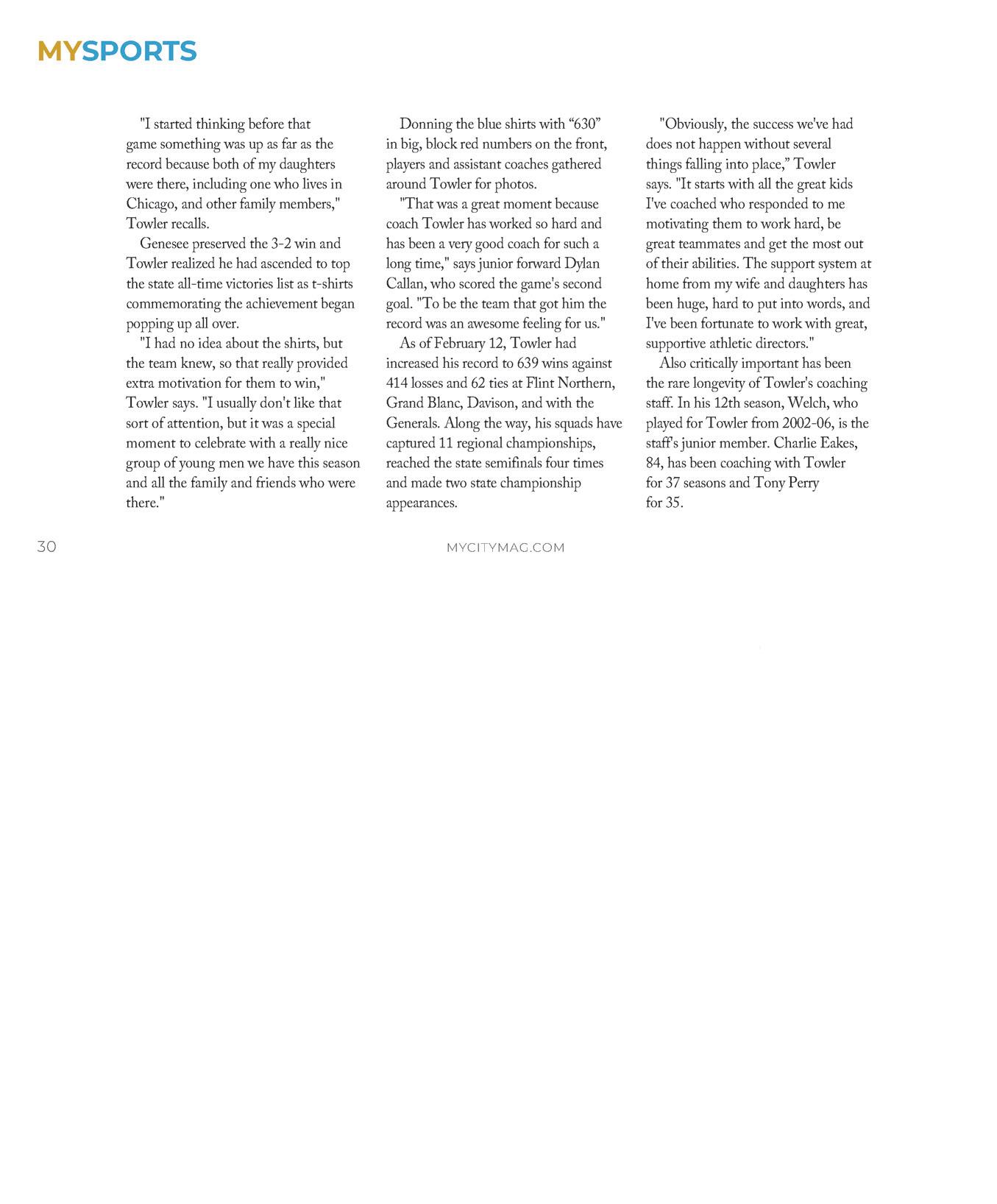



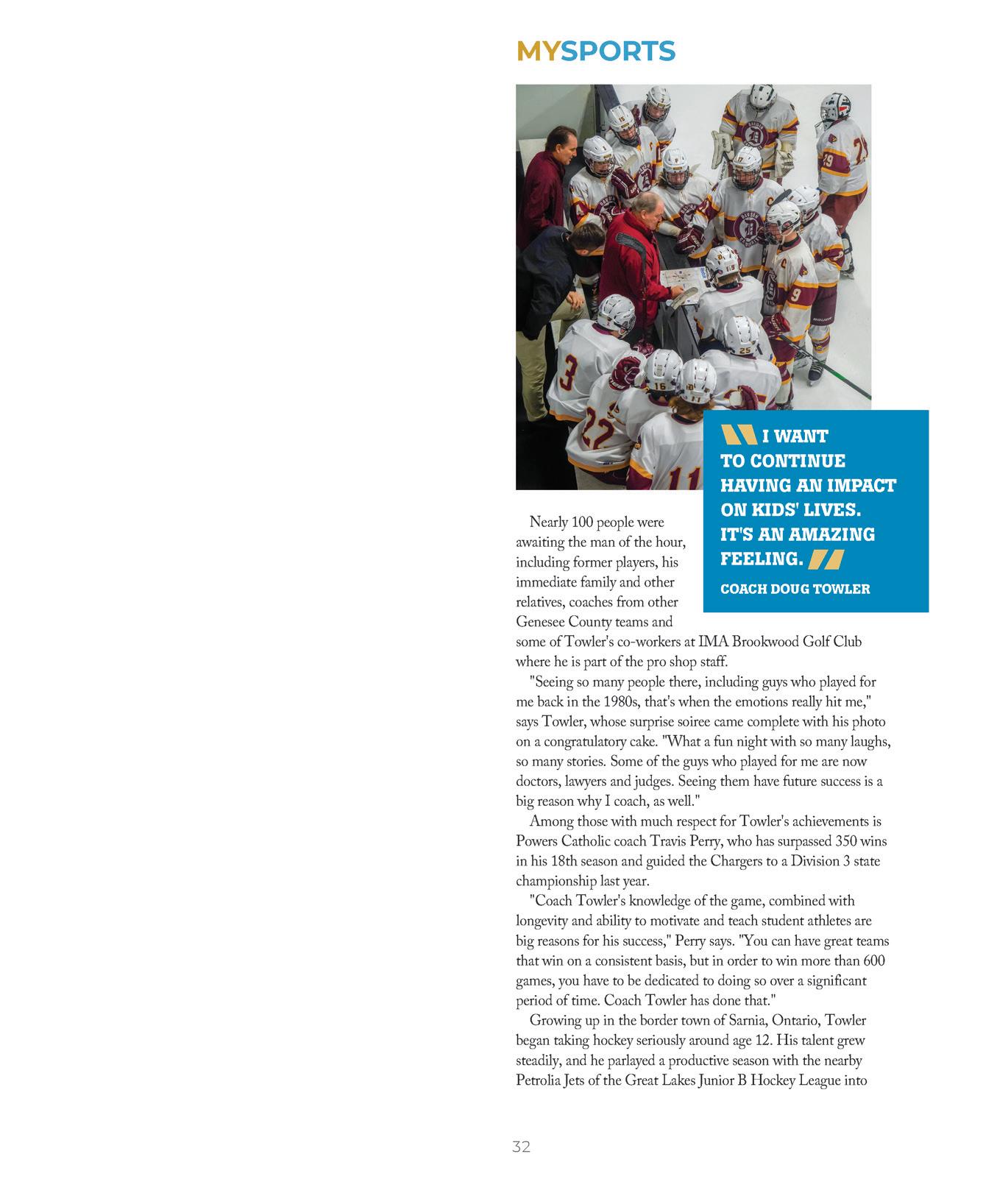

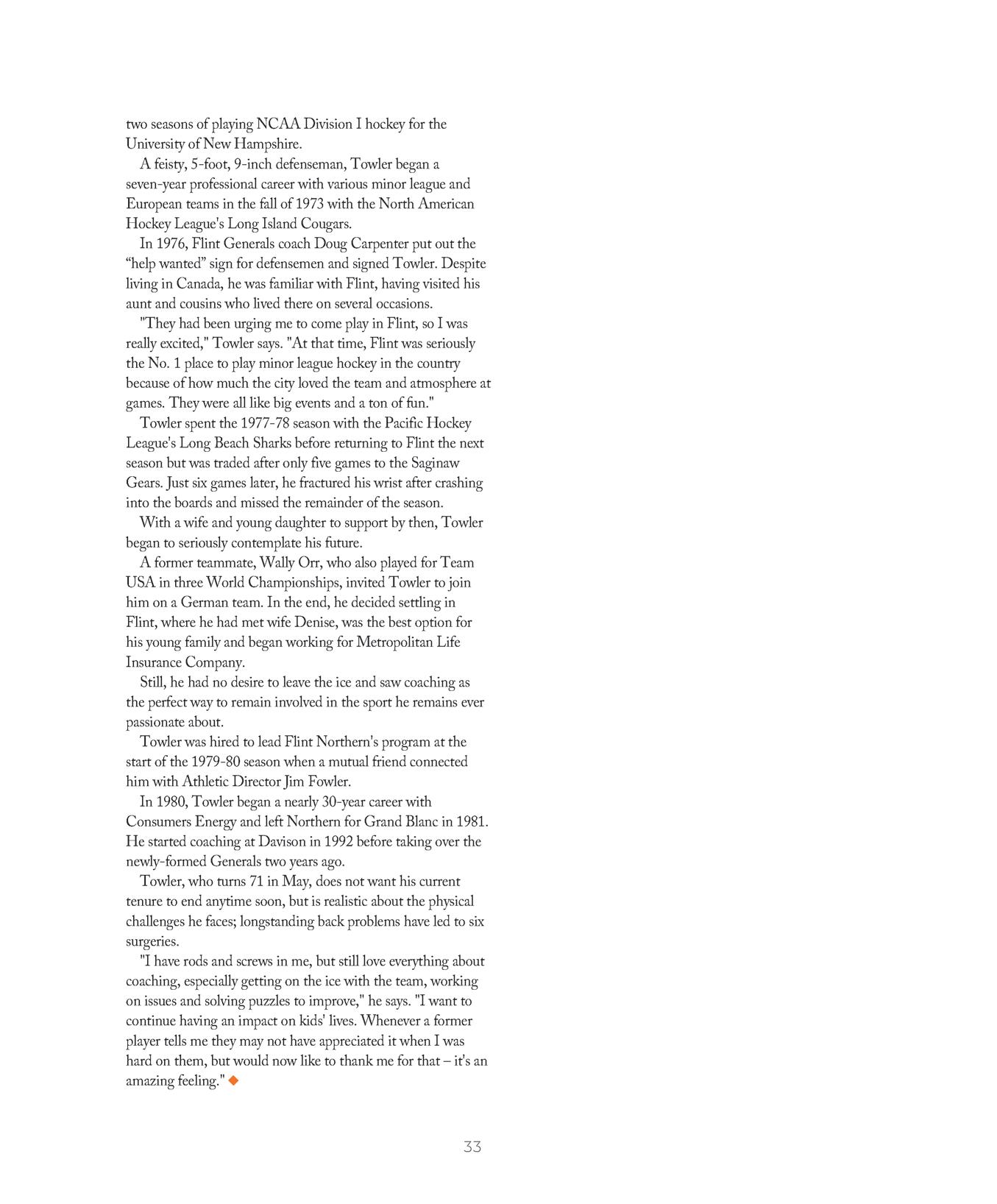




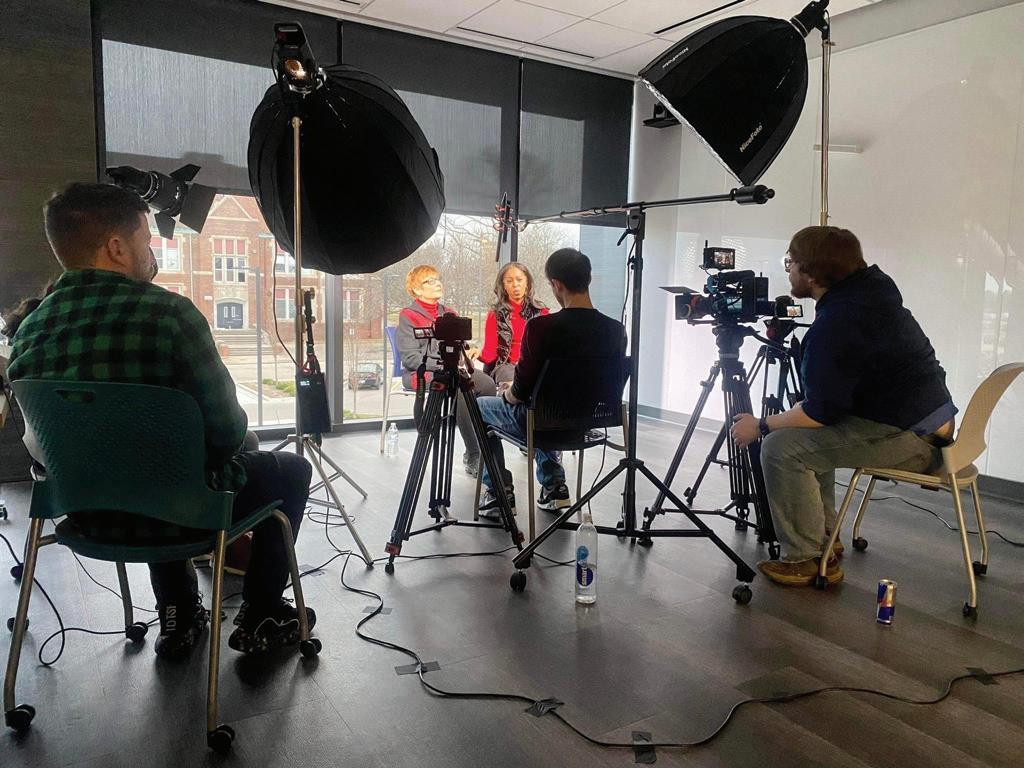
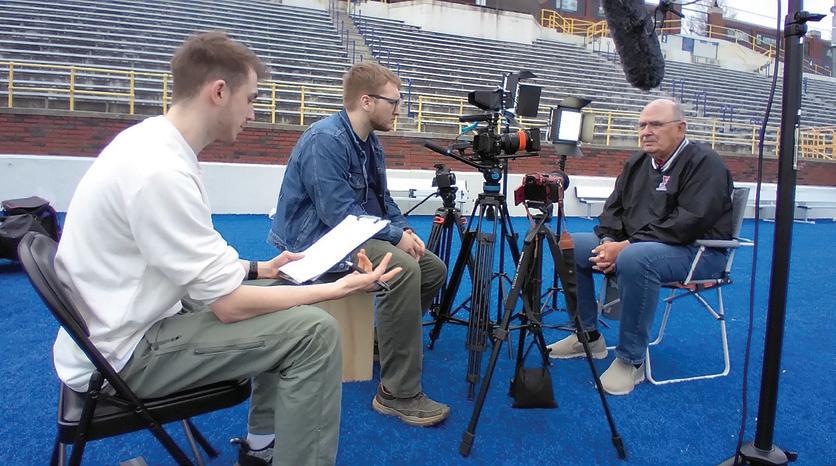
to demolish the vacant campus at an estimated cost of $3 million. e vote was deadlocked at 3-3, thus the proposal failed. Several other elementary schools in the district were closed, as well.
e idea and drive to shine a light on the school came to Johnson while he was attending Mott Community College. “ e history and architecture of the area I grew up in has always been interesting
FOR HIS FILM, JOHNSON INTERVIEWED NUMEROUS PEOPLE CONNECTED WITH FLINT CENTRAL. ABOVE, HE INTERVIEWS FORMER TEACHER JANET HAFFNER AND STUDENT KAYCE SHEPARD.
LEFT: JOHNSON INTERVIEWS FORMER CENTRAL COACH JOE EUFINGER AT ATWOOD STADIUM.

to me,” he remarks. “I drove by the Flint Central building every day and was fascinated by it. I thought that someone should preserve its legacy.” As of today, the structure still remains. With all the schools being demolished in Flint, Johnson knew that could change at any moment; so he quickly got to work.
Johnson delved into the building’s history. He perused the archives
and became amazed by the school’s impact on the Flint community and beyond. “Flint Central was important, not just to the city, but to the entire world,” he states. “At the start, I didn’t understand just how important it was. For example, (GM co-founder) Billy Durant attended Flint High School, which became Flint Central. Just his contribution alone was enough! He was a big one.” Johnson’s lm touches on more than a few stand-out alumni.
After research, Johnson’s next step was to gather and talk to those who were close to the school. He interviewed historians, teachers and alumni who spoke about what the school meant to them and to the area. With many telling stories of its glory days, the guest speakers include: historian/alumni Gary Fisher, football coaching legend Joe

Eu nger, architecture enthusiast/ alumni Garry McDaniel, teacher Janet Ha ner, alumni Judge omas Yeotis, theater instructor Martin Jennings and many others. “I am very thankful that I connected with so many great people with ties to the school,” adds Johnson. “Without their contributions, there is no
narrative for the documentary.”
e lm begins with history and winds its way through stories and memories of Flint Central and its impact on the community. “While working on the project, one of the things that surprised me the most was the amount of pride that people had for the school,” says Johnson. “It was re ected in their stories and in the spirit of the Flint community; the resilience of its students, the rich diversity of the school and the power of its education really come through.”
A signi cant theme of the lm is how Flint Central High School directly mirrored the socioeconomic status of the city at-large, directly re ecting the decisions made in the city and the changes there. It was never a separate institution – it was tied to the community. “For example,” Johnson states, “as soon as




General Motors began leaving the city, Flint Central began to change. Everything is a ected. It’s all connected – nothing stands on its own. It’s a lesson that applies to every school and city in the country and a message that needs to get out.”
Another message Johnson wants to share with the world is about

Flint, itself. “I’m tired of hearing about all the negative aspects of Flint when I tell people where I’m from,” he says. “ ey all think Flint is a violent city with poisoned water. Nobody understands the contributions the city has made. Nobody realizes how Flint changed the entire world. Nobody understands

the resilience of the people here. I’m hoping that ‘Remembering Flint Central’ can start to change their perceptions.”
While researching the school’s history, Johnson couldn’t help but contemplate its future. “Something needs to happen,” he states. “Whether it’s demolition or rehabilitation,
→


“The stories reflect the spirit of the Flint community; the resilience of its students, the rich diversity of the school and the power of its education really come through.”
Lance Johnson
Filmmaker
it can’t just sit there any longer to rot. ere were so many plans made for the building but nothing has ever happened. We need to nally commit to a vision for the future and move forward toward that.

Continuing to do nothing will only make it worse. It’s been too long.”
“Remembering Flint Central” premiered at the Flint Institute of Arts on March 3rd to a sold-out crowd.
“I did not expect it to sell out so fast!” Johnson exclaims. “I thought it might take a week, but it sold-out in ve hours!” Another showing is
planned for late April at a bigger venue. For more information, visit the Remembering Flint Central Facebook page.
With one documentary under his belt, Lance Johnson is busy making plans for many more. “I’m working on several projects that include the big players such as Billy Durant, Charles Stewart Mott, Louis Chevrolet and others. I’m also planning a sports documentary featuring the Flint basketball teams of the 80s, but I’m currently fascinated by the history of the anksgiving Day football game between

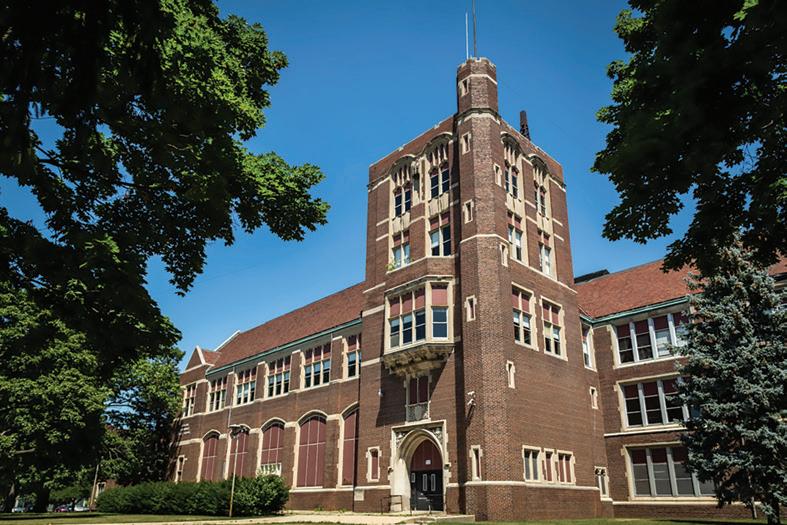
Flint Central and Flint Northern. I couldn’t touch on it as much as I wanted to in the Flint Central documentary – I think it deserves a 30-minute lm all its own. I’m not done telling Flint’s story.”
Lance Johnson is looking for more memories! He invites anyone with a connection to Flint Central High School to submit a short video recording of your favorite story or memory. For more information, visit the Remembering Flint Central Facebook page. ◆








Being a teenager is tough enough – but when you add attention de cit hyperactivity disorder (ADHD) to the mix, the typical challenges can become even more daunting. ADHD, formerly known as ADD, is a condition that makes it exceptionally di cult for both children and adults to concentrate on tasks, pay attention, sit still, and control impulsive behavior.
Lynn, mother of 14-year-old Zane and diagnosed with ADHD two years ago, shared her experience, saying, “Having a child trying to navigate the teenage years is hard enough; throw in ADHD to the mix, and it’s a challenge for all of us.” Lynn initially struggled to identify Zane’s ADHD since he was getting decent grades and did not t her stereotype of a child with ADHD.
Dr. F. Elamin, who treats Zane, is a pediatrician at Hamilton Community Health Network’s North Pointe Clinic. He explains that there are two types of ADHD: Hyperactive or Impulsive ADHD, and Inattentive ADHD, like the type Zane has. “Some parents may associate ADHD with children who are ‘jumping o the walls’ or just cannot sit still, but many kids and adults with ADHD have the inability to focus or concentrate on a task or several tasks in a row,” Dr. Elamin explains.
Lynn initially interpreted Zane’s behaviors as laziness and a lack of caring. However, upon overhearing Zane say, “I hate my brain” to himself, Lynn realized there might be more to his struggles and promptly scheduled an appointment with Dr. Elamin.
Dr. Elamin has treated many children over the years who have dealt with ADHD. He stresses the importance of early intervention. “People with ADHD often have underlying neurological issues such as anxiety and depression. In fact, teenagers with ADHD are at a higher risk of suicide.” He encourages parents to discuss their child’s school, grades and behaviors with their pediatrician regularly, as this helps to e ectively diagnose and treat them. ough it had taken about nine years of struggles, Lynn and Zane found relief in understanding the root of his struggles. However, they also recognized that the journey was not over. Dr. Elamin recommended Zane and Lynn each identify the biggest challenges Zane faces, then choose one skill to improve. By choosing one area to focus on, it is not as overwhelming.
Since there is currently no cure for ADHD, treatment focuses on symptom management. Symptoms may change with age, and teens and adults often require ongoing treatment to e ectively manage them.
“PEOPLE WITH ADHD OFTEN HAVE UNDERLYING NEUROLOGICAL ISSUES SUCH AS ANXIETY AND DEPRESSION. IN FACT, TEENAGERS WITH ADHD ARE AT A HIGHER RISK OF SUICIDE.”
F. ELAMIN, MB, BS
For those with a teen or loved one diagnosed with ADHD, it is essential to remember that it is not a aw or weakness. Rather, it is about helping them manage their condition. Lynn re ects, “Living with ADHD is a challenge at times, but it is just a part of Zane. So, we keep working on skills, and just yesterday I found him cleaning and organizing his room. I was ecstatic!” →



Dr. Elamin’s best advice for parents is patience, patience, patience. “Kids cannot change their neurodevelopmental disorders. As a parent or caregiver, provide them with the tools or skills needed to manage their symptoms. Seek treatment and work to manage it, just as you would with any health problem.”
By fostering understanding, patience and support, families can help their teens with ADHD navigate the challenges they face and thrive despite their condition.
• Hyperactive children need to learn to slow down and develop skills to calm themselves or burn o excess energy.
• Impulsive children need to learn patience and to think before they act. ey may also need to learn to regulate their emotions.
• Teens struggling with focus and attentiveness should work on developing organizational skills and time management techniques.
If you suspect your child may be struggling with a form of ADHD, call Hamilton Community Health Network at 810.406.4246. Dr. Elamin’s practice is at the North Pointe Clinic, plus Hamilton has a signi cant behavioral health department with therapists who can help your child manage his or her symptoms of ADHD. ◆

01.20.2024
Photos by Marktavius Nichols & Michael Gleason Photography
Presented by the Flint Institute of Arts and Communities First, Inc. this event gathered patrons of the arts to celebrate the exhibition opening for Revolutionary Times. Following an informative talk by the artist – Detroit native Mario Moore – attendees enjoyed viewing the exhibit during a cocktail reception featuring hors d’oeuvre and live entertainment. Revolutionary Times draws from three bodies of work by Moore; paintings, silverpoint drawings and works on paper that focus on American history and current connections to the past. ere are currently 37 works on view through April 14 in the FIA Hodge & Henry Galleries. is year’s Gala raised a record $68,000 in funds to support expansion and enhancement of the African American collection and African diaspora artists featured at the FIA.
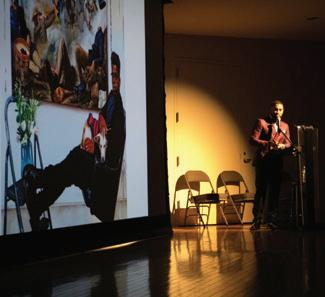


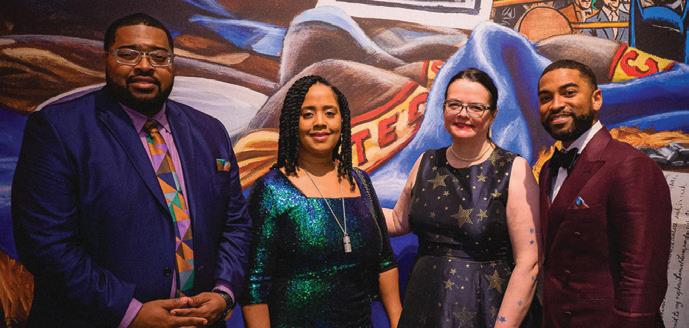



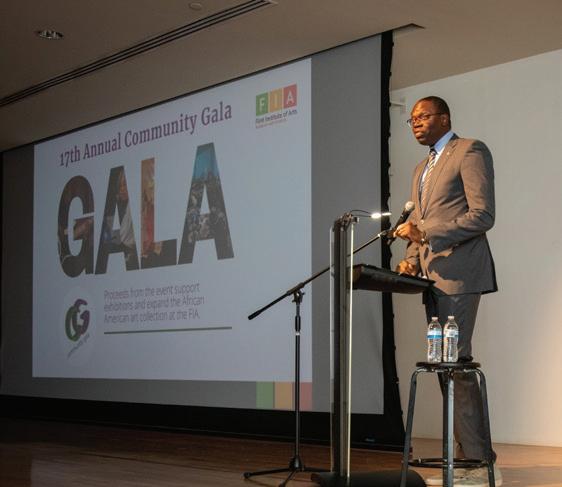



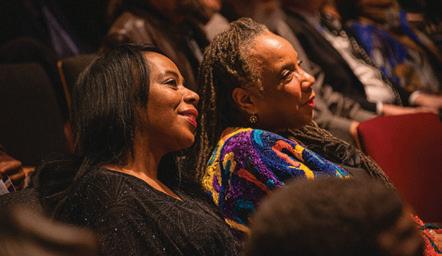
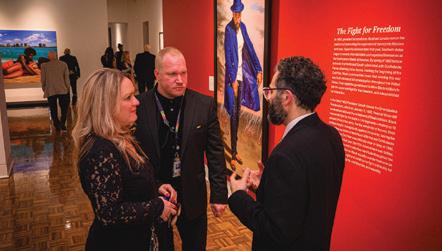
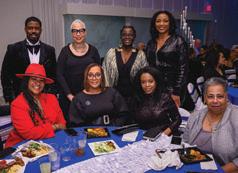




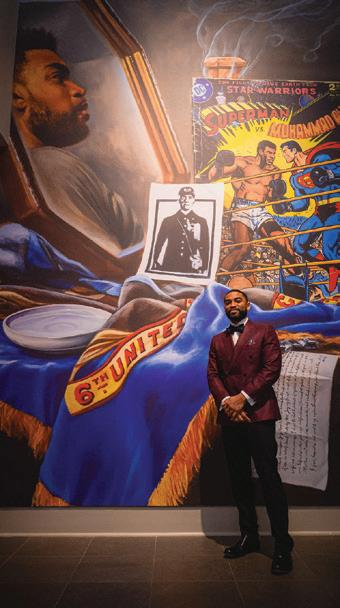
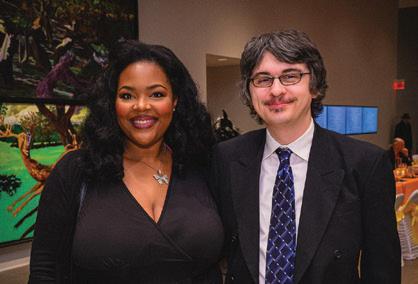

02.03.2024
Photography by Jenn AlexanderFOR
the past 25 years, this event has been vital in raising funds for the Flint School of Performing Arts tuition assistance program, ensuring that students can study music, dance and theater regardless of their ability to pay. Last year alone, the Seeing Stars! tuition assistance program awarded $230,000 to local FSPA performing arts students and their families. Sixty percent of the FSPA’s enrolled families receive support.
After enjoying a tapas-style tasting of delicious food provided by many local restaurants, the attendees enjoyed a Student Showcase of inspiring performances in MacArthur Recital Hall. e evening concluded with champagne and desserts donated by several area bakeries.
e largest community school of the arts in Michigan and one of the country’s most comprehensive performing arts instructional programs, FSPA has helped students of all ages discover a world of music, dance and theatre in stateof-the-art facilities.

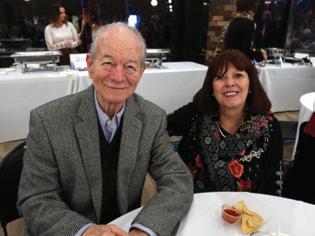

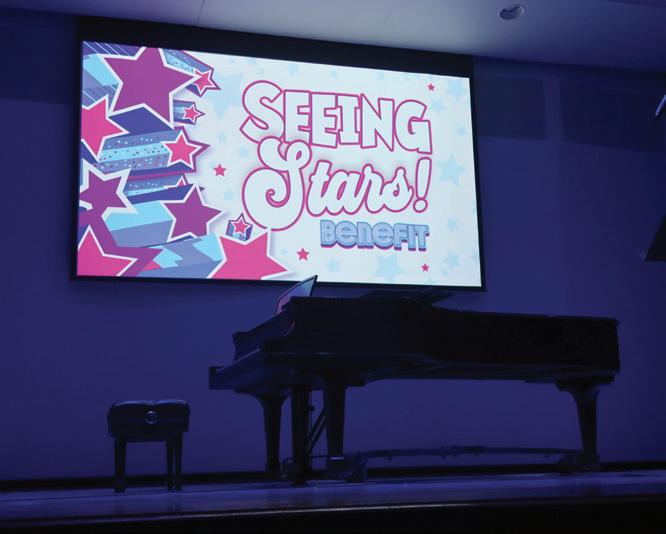
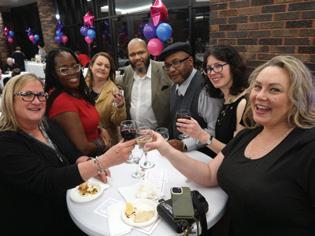

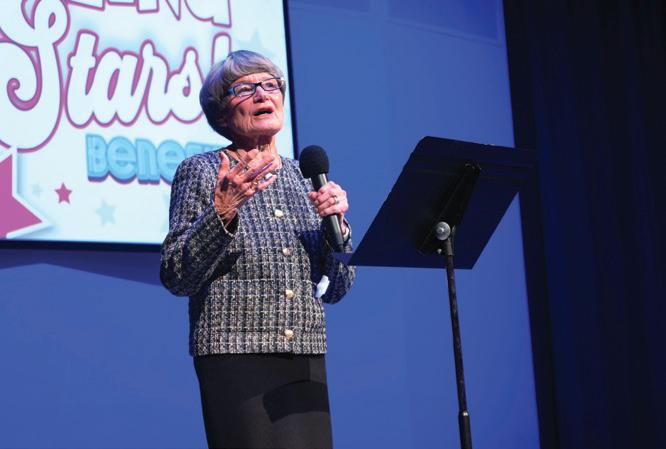
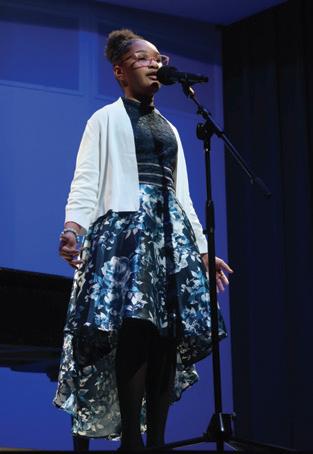
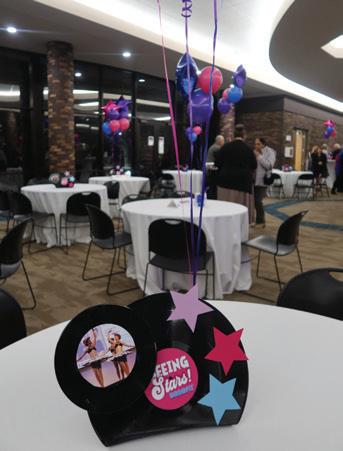





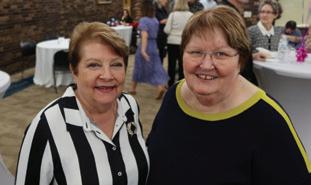

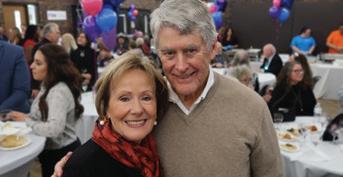


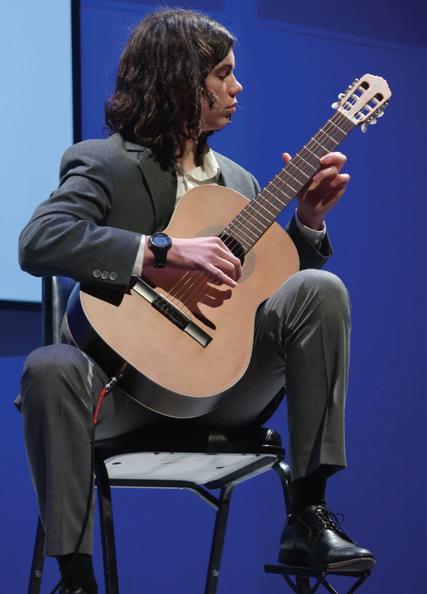


Photos Provided by Various Contributors
Co-sponsored by Dort Financial Credit Union and General Motors with 50 others lending support, the 9th annual family-friendly event was themed “Shake, Rattle & Roll” a tribute to the 1950s. e three-day event showcased a collection of 122 classic and custom vehicles – sports cars, muscle cars, hot rods, trucks, and a handful of custom motorcycles lling the two arenas, hallways and mezzanine of the Dort Financial Center. In the lobby, a variety of vintage cars, gas pumps and neon were displayed, with a collection of GTOs taking center stage on the ice.
Attendees enjoyed a variety of concessions and demonstrations, with 70 vendors displaying automotive-related items for sale. Friday night’s sold-out VIP Experience featured gourmet hors d’oeuvre and desserts in the Blue Line Room, with live entertainment by local rock band Johnny and e Monsters.
Sunday’s schedule included an awards ceremony, as well as the Miss Chrome & Ice pageant sponsored by Vehicle City Motors. Taking home the crowns were Miss Chrome & Ice 2024 - Victory Starr; Miss Kustom Kitten - Greta Grenadine; Miss Crusin’ Cutie - Ms. Sweet Tea Pie and Miss Vivacious Vixen - Gigi Gallows.
Proceeds from Chrome & Ice™ and the VIP Experience will support the Back to the Bricks® Youth Scholarship Fund. ◆









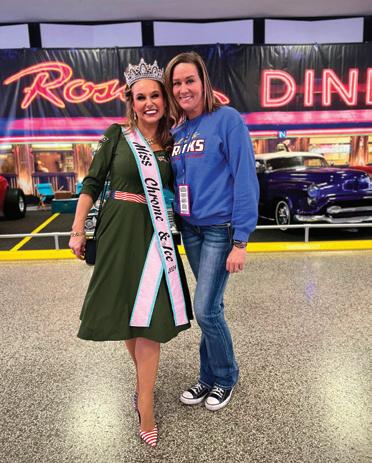













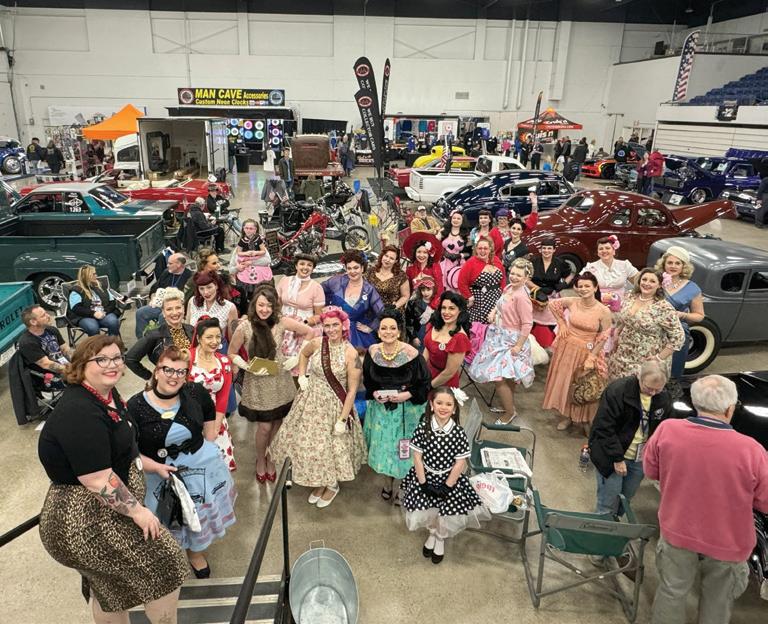

Mar. 8
Blind Boys of Alabama
The Capitol Theatre
Mar. 15
Diamond Rio
The Capitol Theatre
Mar. 9
FSO Presents: Rossini, Paganini, & Respighi
The Whiting
Mar. 10
Powerman 5000
The Machine Shop
Mar. 1524
Twilight Zone Live Parody Show
Flint Local 432
Mar. 16
Flint Firebirds vs. Windsor Spitfires
Dort Financial Center
Mar. 1213
“On Their Feet: The Story of Emilio & Gloria Estefan”
The Whiting
Mar. 13
Flint Firebirds vs. Soo Greyhounds
Dort Financial Center
Mar. 16 - 18
Flint Regional Science & Engineering Fair
University of Michigan-Flint
Mar. 18
Genesee Wind Symphony
“Borrowed and Original Masterworks”
The Whiting



Mar. 20 Mar. 21
Flint Under the Stars: Classical Fenton Community Orchestra
The Capitol Theatre
Children’s Champion Awards Riverfront Conference Center
Mar. 22
Creed Fisher
The Machine Shop
Tribute to Bon Jovi and Journey
The Capitol Theatre
Mar. 22Apr. 7 Mar. 21 Mar. 24 Mar. 29 Apr. 4
“'Night Mother”
Mar. 2230 Mar. 2224
Fenton Village Playhouse Theatre
“Proof” UM-Flint Theatre
“Edward Albee’s Who’s Afraid of Virginia Woolf”
Flint Repertory Theatre
GFAASHOF Induction Ceremony Genesys Conference & Banquet Center
David Cook
The Capitol Theatre
Jo Dee Messina
The Capitol Theatre
See you there!

Few things are as cute as a puppy. In fact, they are so lovable, there is an entire day – National Puppy Day – dedicated to the little fur babies on March 23. e day is set aside, in part, to remind people to adopt shelter puppies, especially given the prevalence of puppy mills. In reality, however, it is not puppies that have the toughest time in shelters.
At a shelter, puppies are the rst to be adopted. Adult dogs are a di erent story. If Champ and Wally could talk, they could tell you countless stories about being looked over by Humane Society of Genesee County (HSGC) visitors. ese two fellas have spent roughly two years at the shelter, desperately waiting for fur-ever homes.
I featured Champ in my November 2023 column. He su ered a serious knee injury and had surgery over the summer of ‘23 to repair it. Champ has made the rounds as an ambassador for the HSGC, winning over event attendees with his charm and easygoing disposition. He has even been adopted more than once, only to be returned to the shelter. Champ was last returned to the shelter in February of 2023. He’s been there ever since,
despite being a good boy, loved by shelter sta and volunteers. Each day, he sits in his kennel watching people walk by, hoping someone will stop and see something in those eyes that they simply cannot walk away from.
Wally has been at the HSGC for nearly two years, arriving as a cruelty case covered in sores and full of fear. Slowly, day by day, shelter sta and volunteers have watched this sweet boy come out of his shell. e trouble is, Wally is still shy and a little fearful when strangers on the hunt for a new best friend pass by his kennel. He can be a bit of a wall ower – until you get to know him.
Two very di erent dogs. Two di erent stories. e same heartbreaking reality: until someone stops and takes the time to see that they are worth adopting, these two fellas will live in kennels at the shelter. e HSGC quali es as a no-kill facility; the policy is to


get each animal that enters the shelter adopted, no matter how long or what it takes.

Usually, when I mention one of the shelter long-timers to a friend or acquaintance, their rst question is, “What is wrong with the dog?”
What is wrong with any of us, really? I have yet to meet anyone who quali es as perfect. We are all awed and a little broken in some way. If we weren’t, there would be no need for unconditional love – something dogs know how to give better than any other creature.
If you want to learn more about Wally, Champ, or any of the sweet animals at the Humane Society of Genesee County, visit geneseehumane.org. ◆

The federal government is set to add another $1.5 trillion to the national debt this year. To put this in perspective, note that one trillion is a thousand billion. A billion seconds is roughly 32 years – thus, a trillion seconds is 32,000 years. e national debt currently stands at $34 trillion. Counting to $34 trillion, assuming each number took one second to count, would take roughly one million years. e Great Lakes were not even formed yet one million years ago! e debt-toGDP ratio is now at 120% – what it was during World War II. is is an unfathomable amount of debt.
e federal budget was last balanced in 2001. What would it take to balance it again? e options are not good. Consider federal spending in 2022. e federal government spent $1.2 trillion on Social Security, $1 trillion on defense and the Veterans Administration, $750 billion on Medicare, $600 billion on welfare, $500 billion paying interest on the national debt, $1.2 trillion on transfers to the 50 states for things like education and Medicaid, and $1.2 trillion on everything else the government does. In 2024, interest payments on the national debt are set to double given the increase in interest rates since 2022.
To nance this spending, the government collected $2.6 trillion in individual income taxes, $1.5 trillion in payroll taxes, $400 billion in corporate income taxes, $100 billion in tari s, $88 billion in federal sales taxes such as the federal gasoline tax and $300 billion in other taxes. is resulted in a $1.5 trillion de cit that was added to the national debt. Note that for as much attention as they get, corporate taxes and tari s are not a signi cant source of federal revenue.
Consider what it would take to balance the budget. Doing so through tax increases alone would require doubling the payroll tax, or a 50% increase in income taxes across the

board. “Taxing the rich” is nowhere near su cient to achieve budgetary balance. Such a massive tax increase would lead to political unrest, a severe recession and widespread tax avoidance that would result in less tax revenue than anticipated collected and thus, the budget not being balanced.
In terms of cutting spending, the government could end all Social Security payments or end all military spending and the budget still would not balance. e government could eliminate everything it does except pay for entitlements, defense, interest on the debt, and still not balance the budget without nding a few hundred billion dollars in cuts somewhere else. is would mean no transportation, no national parks, etc. Life would grind to a halt, at least in the short term.
Balancing the budget requires a bipartisan, long-term plan consisting of a combination of spending cuts and tax increases, which is unlikely achievable, given our political divide. Unsustainable debt has sunk more than one country. e longer the U.S. goes without getting its scal house in order, the greater the risk that it will sink ours, too. ◆

Dr. Christopher Douglas came to the University of Michigan-Flint in 2006. He earned a B.S. in Electrical Engineering and a B.S. in Economics from Michigan Technological University in 2001, and his Ph.D. in Economics from Michigan State University in 2007. A Professor of Economics and Acting Associate Dean of the College of Arts, Sciences and Education at UM-Flint, he teaches Principles of Microeconomics, Principles of Macroeconomics, International Economics, Public Finance, and Sports Economics.
/
/
/


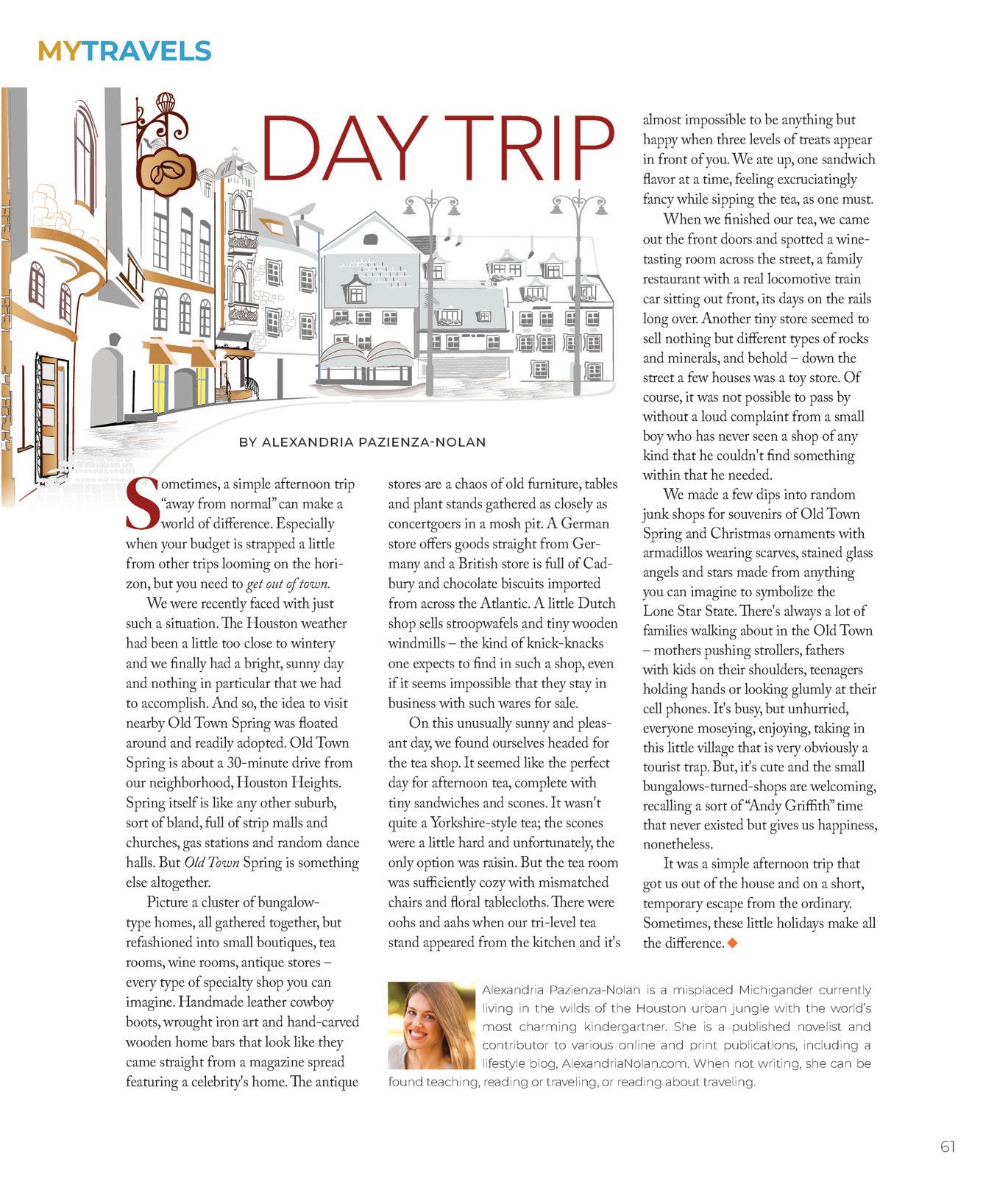



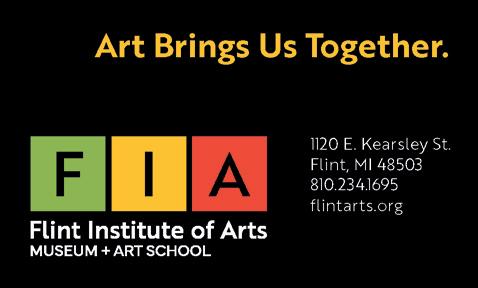



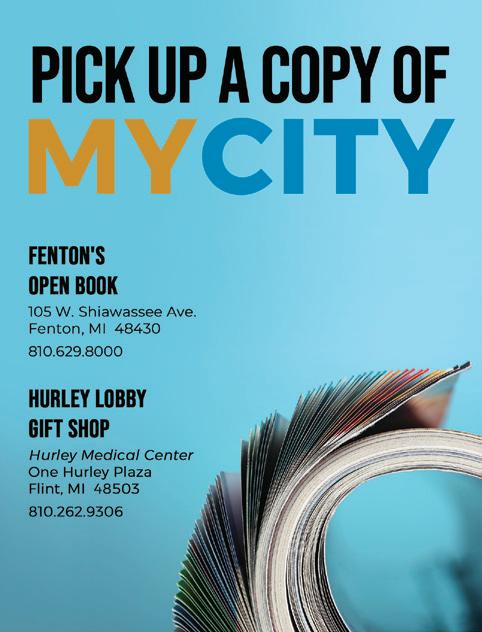
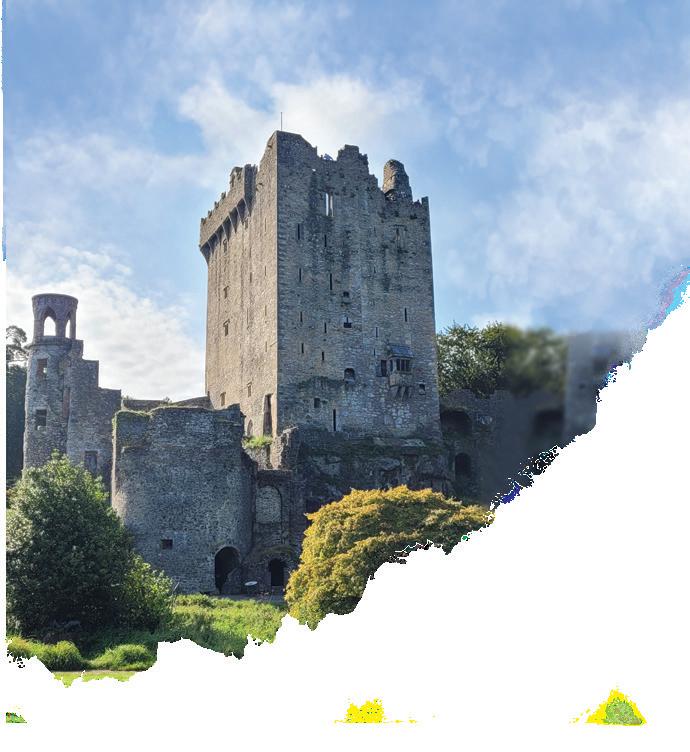
Atthe top of the tallest tower of Blarney Castle in Cork County, Ireland sits a stone with magical properties. Legend says that whoever places their lips upon the stone will have “the gift of gab” or “blarney” as it has been called. ereafter, those who receive the gift are destined to speak with persuasiveness and eloquence to those engaged in conversation. Its powers have been bestowed upon professionals from all over the globe including Winston Churchill, Ronald Reagan, Mick Jagger, Laurel & Hardy, and others. It is estimated that more than 400,000 people kiss the Blarney Stone per year. What brings so many people to the stone and how did it gain its powers?
Blarney Castle was built in 1446 by Dermot McCarthy and according to legend, was so named by Queen Elizabeth I after McCarthy continually talked his way out of negotiations aimed at transferring the castle to her property. e Queen called his obfuscations and verbal gymnastics “blarney” in response. It was believed that McCarthy’s “gift of gab” came from a magical stone used in the construction of the castle.
ere are many myths about the source of the stone’s powers. One states that the rock was used as a pillow by Jacob, patriarch of the Israelites, and was stolen by Christian soldiers during the Crusades, transported to Scotland and eventually, to Cork. Another tale states that the stone was part of the “Stone of Scone’’ and a gift from King Robert the Bruce to the McCarthys for sending 5,000 soldiers to Scotland. Still another legend states that the stone was a gift from the Queen of Fairies who fell in love with the McCarthy Chieftain. Whatever the reason, the stone remains one of the world’s most beguiling objects and if given the chance, one should attempt to obtain its powers – the gift of gab – something I was able to do in the fall of 2023.
1. Wait for a clear day. The stone sits open to the elements at the top of Blarney Castle. Rain will prohibit access and can make for a real wet and miserable experience.
2. Get there early. The line can get long – it begins at the castle entrance and winds through the entire structure. Also, the castle and grounds are interesting in themselves and you will want time to explore. Don’t miss the Poison Garden and the Carnivorous Courtyard.
3. Core strength and flexibility required. To kiss the stone, one lies on their back and bends their body backwards while holding onto metal supports and being supported by an attendant. You will be kissing the stone upside-down and the bend is a little more than you would think; it can be uncomfortable to those with excess weight or back problems.
“‘Tis there’s the stone that whoever kisses He never misses to grow eloquent; ‘Tis he may clamber to a lady’s chamber, Or become a member of Parliament. A noble spouter he’ll sure turn out, or An out and outer to be let alone; Don’t try to hinder him, or to bewilder him, For he is a pilgrim from the Blarney Stone.”
– Francis Sylvester Mahoney